Many of the breakthroughs in modern biology came after Watson and Crick published their model of DNA in 1953. However, chromosomes were identified earlier. In what decade did scientists first identify chromosomes?
(a) 1880s
(b) 1920s
(c) 1940s
(d) 1780s
(a) 1880s
Mitotic chromosomes were first visualized with the use of very simple tools: a basic light microscope and some dyes. Which of the following characteristics of mitotic chromosomes reflects how they were named?
(a) motion
(b) color
(c) shape
(d) location
(b) color
In the 1940s, proteins were thought to be the more likely molecules to house genetic information. What was the primary reason that DNA was not originally believed to be the genetic material?
(a) DNA has a high density of negative charges.
(b) Nucleotides were known to be a source of chemical energy for the cell.
(c) Both protein and nucleic acids were found to be components of chromosomes.
(d) DNA was found to contain only four different chemical building blocks.
(d) DNA was found to contain only four different chemical building blocks.
In a DNA double helix, _____________________.
(a) the two DNA strands are identical.
(b) purines pair with purines.
(c) thymine pairs with cytosine.
(d) the two DNA strands run antiparallel.
(d) the two DNA strands run antiparallel.
You are a virologist interested in studying the evolution of viral genomes. You are studying two newly isolated viral strains and have sequenced their genomes. You find that the genome of strain 1 contains 25% A, 55% G, 20% C, and 10% T. You report that you have isolated a virus with a single-stranded DNA genome. Based on what evidence can you make this conclusion?
(a) single-stranded genomes always have a large percentage of purines
(b) using the formula: G – A = C + T
(c) Double-stranded genomes have equal amounts of A and T
(d) Single-stranded genomes have a higher rate of mutation
(c) Double-stranded genomes have equal amounts of A and T
DNA molecules, like proteins, consist of a single, long polymeric chain that is assembled from small monomeric subunits.
true or false
False. DNA is double-stranded. It is actually made of two polymers that are complementary in sequence.
The polarity of a DNA strand results from the polarity of the nucleotide subunits.
true or false
True.
There are five different nucleotides that become incorporated into a DNA strand.
true or false
False. There are four different nucleotides that are used to make a DNA polymer: adenine, thymine, guanine, and cytosine. A fifth nucleotide, uracil, is found exclusively in RNA molecules, replacing thymine nucleotides in the DNA sequence.
Hydrogen bonds between each nucleotide hold individual DNA strands together.
true or false
False. Nucleotides are linked covalently through phosphodiester bonds. Hydrogen-bonding between nucleotides from opposite strands holds the DNA molecule together.
Several experiments were required to demonstrate how traits are inherited. Which scientist or team of scientists first demonstrated that cells contain some component that can be transferred to a new population of cells and permanently cause changes in the new cells?
(a) Griffith
(b) Watson and Crick
(c) Avery, MacLeod, and McCarty
(d) Hershey and Chase
(a) Griffith
Several experiments were required to demonstrate how traits are inherited. Which scientist or team of scientists obtained definitive results demonstrating that DNA is the genetic molecule?
(a) Griffith
(b) Watson
(c) Crick
(d) Hershey and Chase
(d) Hershey and Chase
Fred Griffith studied two strains of Streptococcus pneumonia, one that causes a lethal infection when injected into mice, and a second that is harmless. He observed that pathogenic bacteria that have been killed by heating can no longer cause an infection. But when these heat-killed bacteria are mixed with live, harmless bacteria, this mixture is capable of infecting and killing a mouse. What did Griffith conclude from this experiment?
(a) The infectious strain cannot killed by heating.
(b) The heat-killed pathogenic bacteria “transformed” the harmless strain into a lethal one.
(c) The harmless strain somehow revived the heat-killed pathogenic bacteria.
(d) The mice had lost their immunity to infection with S. pneumoniae.
(b) The heat-killed pathogenic bacteria “transformed” the harmless strain into a lethal one.
Hershey and Chase used radiolabeled macromolecules to identify the material that contains heritable information. What radioactive material was used to track DNA during this experiment?
(a) 3H
(b) 14C
(c) 35S
(d) 32P
(d) 32P
Which of the following chemical groups is not used to construct a DNA molecule?
(a) five-carbon sugar
(b) phosphate
(c) nitrogen-containing base
(d) six-carbon sugar
(d) six-carbon sugar
Which of the following structural characteristics is not normally observed in a DNA duplex?
(a) purine–pyrimidine pairs
(b) external sugar–phosphate backbone
(c) uniform left-handed twist
(d) antiparallel strands
(c) uniform left-handed twist
Which of the following DNA strands can form a DNA duplex by pairing with itself at each position?
(a) 5′-AAGCCGAA-3′
(b) 5′-AAGCCGTT-3′
(c) 5′-AAGCGCAA-3′
(d) 5′-AAGCGCTT-3′
(d) 5′-AAGCGCTT-3′
The DNA from two different species can often be distinguished by a difference in the ______________________.
(a) ratio of A + T to G + C.
(b) ratio of A + G to C + T.
(c) ratio of sugar to phosphate.
(d) presence of bases other than A, G, C, and T.
(a) ratio of A + T to G + C.
Because hydrogen bonds hold the two strands of a DNA molecule together, the strands can be separated without breaking any covalent bonds. Every unique DNA molecule “melts” at a different temperature. In this context, T m (melting temperature) is the point at which two strands separate, or become denatured. Order the DNA sequences listed below according to relative melting temperatures (from lowest T m to highest T m). Assume that they all begin as stable double-stranded DNA molecules.
A. GGCGCACC
B. TATTGTCT
C. GACTCCTG
D. CTAACTGG
1—B; 2—D; 3—C; 4—A
Each strand of DNA contains all the information needed to create a new double-stranded DNA molecule with the same sequence information.
true or false
True.
All functional DNA sequences inside a cell code for protein products.
true or false
False. Some sequences encode only RNA molecules, some bind to specific regulatory proteins, and others are sites where specific chromosomal protein structures are built (for example, centromeric and telomeric DNA).
Gene expression is the process of duplicating genes during DNA replication.
true or false
False. Gene expression is the process of going from gene sequence to RNA sequence, to protein sequence.
Gene sequences correspond exactly to the respective protein sequences produced from them.
true or false
False. This statement is false for two reasons. First, genes often contain intron sequences. Second, genes always contain nucleotides flanking the protein-coding sequences that are required for the regulation of transcription and translation.
The complete set of information found in a given organism’s DNA is called its ____________.
(a) genetic code.
(b) coding sequence.
(c) gene.
(d) genome.
(d) genome.
The manner in which a gene sequence is related to its respective protein sequence is referred to as the _________ code.
(a) protein
(b) genetic
(c) translational
(d) expression
(b) genetic
The information stored in the DNA sequences is used directly as a template to make ___________.
(a) lipids.
(b) RNA.
(c) polypeptides.
(d) carbohydrates.
(b) RNA.
The human genome is divided into linear segments and packaged into structures called chromosomes. What is the total number of chromosomes found in each of the somatic cells in your body?
(a) 22
(b) 23
(c) 44
(d) 46
(d) 46
The human genome is a diploid genome. However, when germ-line cells produce gametes, these specialized cells are haploid. What is the total number of chromosomes found in each of the gametes (egg or sperm) in your body?
(a) 22
(b) 23
(c) 44
(d) 46
(b) 23
What type of macromolecule helps package DNA in eukaryotic chromosomes?
(a) lipids
(b) carbohydrates
(c) proteins
(d) RNA
(c) proteins
The process of sorting human chromosome pairs by size and morphology is called karyotyping. A modern method employed for karyotyping is called chromosome painting. How are individual chromosomes “painted”?
(a) with a laser
(b) using fluorescent antibodies
(c) using fluorescent DNA molecules
(d) using green fluorescent protein
(c) using fluorescent DNA molecules
Which of the following questions would not be answered by using karyotyping?
(a) Is the individual genetically female or male?
(b) Do any of the chromosomes contain pieces that belong to other chromosomes?
(c) Does the individual have an extra chromosome?
(d) Do any chromosomes contain point mutations?
(d) Do any chromosomes contain point mutations?
Comparing the relative number of chromosome pairs is a good way to determine whether two species are closely related.
true or false
False. There are several examples of closely related species that have a drastically different number of chromosome pairs. Two related species of deer—Chinese and Indian muntjac—have 23 and 3, respectively.
Chromosomes exist at different levels of condensation, depending on the stage of the cell cycle.
true or false
true
Eukaryotic chromosomes contain many different sites where DNA replication can be initiated.
true or false
true
The telomere is a specialized DNA sequence where microtubules from the mitotic spindle attach to the chromosome so that duplicate copies move to opposite ends of the dividing cell.
true or false
False. The telomere is a specialized DNA sequence, but not for the attachment of spindle microtubules. Telomeres form special caps that stabilize the ends of linear chromosomes.
The chromosomes we typically see in images are isolated from mitotic cells. These mitotic chromosomes are in the most highly condensed form. Interphase cells contain chromosomes that are less densely packed and __________________________.
(a) occupy discrete territories in the nucleus.
(b) share the same nuclear territory as their homolog.
(c) are restricted to the nucleolus.
(d) are completely tangled with other chromosomes.
(a) occupy discrete territories in the nucleus.
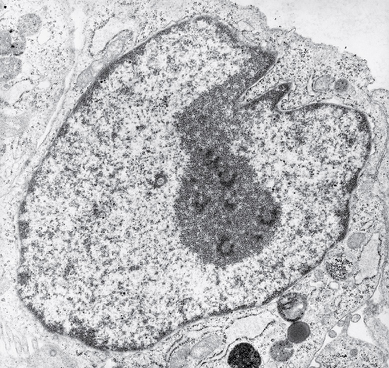
Figure Q5-45 clearly depicts the nucleolus, a nuclear structure that looks like a large, dark region when stained. The other dark, speckled regions in this image are the locations of particularly compact chromosomal segments called ____________.
(a) euchromatin.
(b) heterochromatin.
(c) nuclear pores.
(d) nucleosomes.
(b) heterochromatin.
Specific regions of eukaryotic chromosomes contain sequence elements that are absolutely required for the proper transmission of genetic information from a mother cell to each daughter cell. Which of the following is not known to be one of these required elements in eukaryotes?
(a) terminators of replication
(b) origins of replication
(c) telomeres
(d) centromeres
(a) terminators of replication
Mitotic chromosomes are _____ times more compact than a DNA molecule in its extended form.
(a) 10,000
(b) 100,000
(c) 1000
(d) 100
(a) 10,000
Interphase chromosomes are about______ times less compact than mitotic chromosomes, but still are about______ times more compact than a DNA molecule in its extended form.
(a) 10, 1000
(b) 20, 500
(c) 5, 2000
(d) 50, 200
(b) 20, 500
The classic “beads-on-a-string” structure is the most decondensed chromatin structure possible and is produced experimentally. Which chromatin components are not retained when this structure is generated?
(a) linker histones
(b) linker DNA
(c) nucleosome core particles
(d) core histones
(a) linker histones
Nucleosomes are formed when DNA wraps _____ times around the histone octamer in a ______ coil.
(a) 2.0, right-handed
(b) 2.5, left-handed
(c) 1.7, left-handed
(d) 1.3, right-handed
(c) 1.7, left-handed
The octameric histone core is composed of four different histone proteins, assembled in a stepwise manner. Once the core octamer has been formed, DNA wraps around it to form a nucleosome core particle. Which of the following histone proteins does not form part of the octameric core?
(a) H4
(b) H2A
(c) H3
(d) H1
(d) H1
The core histones are small, basic proteins that have a globular domain at the C-terminus and a long, extended conformation at the N-terminus. Which of the following is not true of the N-terminal “tail” of these histones?
(a) It is subject to covalent modifications.
(b) It extends out of the nucleosome core.
(c) It binds to DNA in a sequence-specific manner.
(d) It helps DNA pack tightly.
(c) It binds to DNA in a sequence-specific manner.
Stepwise condensation of linear DNA happens in five different packing processes. Which of the following four processes has a direct requirement for histone H1?
(a) formation of “beads-on-a-string”
(b) formation of the 30-nm fiber
(c) looping of the 30-nm fiber
(d) packing of loops to form interphase chromosomes
(b) formation of the 30-nm fiber
The histone proteins that constitute the core nucleosome include tetramers of histones H2A, H2B, H3, and H4.
true or false
False. When the core nucleosome is analyzed, it is revealed that there are H2A/H2B tetramers and H3/H4 tetramers in solution. Each of the tetramers has two subunits of the respective histone proteins.
Linker histones help compact genomic DNA by influencing the path of the DNA after it has wrapped about the nucleosome core.
true or false
true
Histone proteins have a lower-than-average number of lysines and arginines in their polypeptide chains.
true or false
False. Histones have a higher number of lysines and arginines than most proteins. These amino acids are positively charged and help to increase the nonspecific affinity between the histones and the negatively charged phosphates in the DNA backbone.
Interphase chromosomes represent a physical state of the chromatin with the highest order of packaging.
true or false
False. When cells enter mitosis, the interphase chromosomes undergo at least one more level of packaging, which facilitates the segregation of sister chromatids.
Although the chromatin structure of interphase and mitotic chromosomes is very compact, DNA-binding proteins and protein complexes must be able to gain access to the DNA molecule. Chromatin-remodeling complexes provide this access by __________________.
(a) recruiting other enzymes.
(b) modifying the N-terminal tails of core histones.
(c) using the energy of ATP hydrolysis to move nucleosomes.
(d) denaturing the DNA by interfering with hydrogen-bonding between base pairs.
(c) using the energy of ATP hydrolysis to move nucleosomes.
The N-terminal tail of histone H3 can be extensively modified, and depending on the number, location, and combination of these modifications, these changes may promote the formation of heterochromatin. What is the result of heterochromatin formation?
(a) increase in gene expression
(b) gene silencing
(c) recruitment of remodeling complexes
(d) displacement of histone H1
(b) gene silencing
Methylation and acetylation are common changes made to histone H3, and the specific combination of these changes is sometimes referred to as the “histone code.” Which of the following patterns will probably lead to gene silencing?
(a) lysine 9 methylation
(b) lysine 4 methylation and lysine 9 acetylation
(c) lysine 14 acetylation
(d) lysine 9 acetylation and lysine 14 acetylation
(a) lysine 9 methylation
When there is a well-established segment of heterochromatin on an interphase chromosome, there is usually a special barrier sequence that prevents the heterochromatin from expanding along the entire chromosome. Gene A, which is normally expressed, has been moved by DNA recombination near an area of heterochromatin. None of the daughter cells produced after this recombination event express gene A, even though its DNA sequence is unchanged. What is the best way to describe what has happened to the function of gene A in these cells?
(a) barrier destruction
(b) heterochromatization
(c) epigenetic inheritance
(d) euchromatin depletion
(c) epigenetic inheritance
Which of the following best describes the mechanism by which chromatin-remodeling complexes “loosen” the DNA wrapped around the core histones?
(a) They use energy derived from ATP hydrolysis to change the relative position of the DNA and the core histone octamer.
(b) They chemically modify the DNA, changing the affinity between the histone octamer and the DNA.
(c) They remove histone H1 from the linker DNA adjacent to the core histone octamer.
(d) They chemically modify core histones to alter the affinity between the histone octamer and the DNA.
(a) They use energy derived from ATP hydrolysis to change the relative position of the DNA and the core histone octamer.
Which of the following is not a chemical modification commonly found on core histone N-terminal tails?
(a) methylation
(b) hydroxylation
(c) phosphorylation
(d) acetylation
(b) hydroxylation
How do changes in histone modifications lead to changes in chromatin structure?
(a) They directly lead to changes in the positions of the core histones.
(b) They change the affinity between the histone octamer and the DNA.
(c) They help recruit other proteins to the chromatin.
(d) They cause the histone N-terminal tails to become hyperextended.
(c) They help recruit other proteins to the chromatin.
Most eukaryotic cells only express 20–30% of the genes they possess. The formation of heterochromatin maintains the other genes in a transcriptionally silent (unexpressed) state. Which histone modification directs the formation of the most common type of heterochromatin?
(a) H3 lysine 4 methylation
(b) H3 lysine 9 methylation
(c) H3 lysine 14 methylation
(d) H3 lysine 27 methylation
(b) H3 lysine 9 methylation
The inactivation of one X chromosome is established by the directed spreading of heterochromatin. The silent state of this chromosome is _______________ in the subsequent cell divisions.
(a) completed
(b) switched
(c) erased
(d) maintained
(d) maintained
The process of DNA replication requires that each of the parental DNA strands be used as a ___________________ to produce a duplicate of the opposing strand.
(a) catalyst
(b) competitor
(c) template
(d) copy
(c) template
DNA replication is considered semiconservative because ____________________________.
(a) after many rounds of DNA replication, the original DNA double helix is still intact.
(b) each daughter DNA molecule consists of two new strands copied from the parent DNA molecule.
(c) each daughter DNA molecule consists of one strand from the parent DNA molecule and one new strand.
(d) new DNA strands must be copied from a DNA template.
(c) each daughter DNA molecule consists of one strand from the parent DNA molecule and one new strand.
The classic experiments conducted by Meselson and Stahl demonstrated that DNA replication is accomplished by employing a ________________ mechanism.
(a) continuous
(b) semiconservative
(c) dispersive
(d) conservative
(b) semiconservative
Initiator proteins bind to replication origins and disrupt hydrogen bonds between the two DNA strands being copied. Which of the factors below does not contribute to the relative ease of strand separation by initiator proteins?
(a) replication origins are rich in A-T base pairs
(b) the reaction can occur at room temperature
(c) they only separate a few base pairs at a time
(d) once opened, other proteins of the DNA replication machinery bind to the origin
(b) the reaction can occur at room temperature
If the genome of the bacterium E. coli requires about 20 minutes to replicate itself, how can the genome of the fruit fly Drosophila be replicated in only 3 minutes?
(a) The Drosophila genome is smaller than the E. coli genome.
(b) Eukaryotic DNA polymerase synthesizes DNA at a much faster rate than prokaryotic DNA polymerase.
(c) The nuclear membrane keeps the Drosophila DNA concentrated in one place in the cell, which increases the rate of polymerization.
(d) Drosophila DNA contains more origins of replication than E. coli DNA.
(d) Drosophila DNA contains more origins of replication than E. coli DNA.
When DNA is being replicated inside a cell, local heating occurs, allowing the two strands to separate.
true or false
False. The two strands do need to separate for replication to occur, but this is accomplished by the binding of initiator proteins at the origin of replication.
DNA replication origins are typically rich in G-C base pairs.
true or false
False. DNA replication origins are typically rich in A-T base pairs, which are held together by only two hydrogen bonds (instead of three for C-G base pairs), making it easier to separate the strands at these sites.
Meselson and Stahl ruled out the dispersive model for DNA replication.
true or false
true
DNA replication is a bidirectional process that is initiated at multiple locations along chromosomes in eukaryotic cells.
true or false
true
How many replication forks are formed when an origin of replication is opened?
(a) 1
(b) 2
(c) 3
(d) 4
(b) 2
How does the total number of replication origins in bacterial cells compare with the number of origins in human cells?
(a) 1 versus 100
(b) 5 versus 500
(c) 10 versus 1000
(d) 1 versus 10,000
(d) 1 versus 10,000
Which of the following statements correctly explains what it means for DNA replication to be bidirectional?
(a) The replication fork can open or close, depending on the conditions.
(b) The DNA replication machinery can move in either direction on the template strand.
(c) Replication-fork movement can switch directions when the fork converges on another replication fork.
(d) The replication forks formed at the origin move in opposite directions.
(d) The replication forks formed at the origin move in opposite directions.
The chromatin structure in eukaryotic cells is much more complicated than that observed in prokaryotic cells. This is thought to be the reason that DNA replication occurs much faster in prokaryotes. How much faster is it?
(a) 2×
(b) 5×
(c) 10×
(d) 100×
(c) 10×
DNA polymerase catalyzes the joining of a nucleotide to a growing DNA strand. What prevents this enzyme from catalyzing the reverse reaction?
(a) hydrolysis of pyrophosphate (PPi) to inorganic phosphate (Pi) + Pi
(b) release of PPi from the nucleotide
(c) hybridization of the new strand to the template
(d) loss of ATP as an energy source
(a) hydrolysis of pyrophosphate (PPi) to inorganic phosphate (Pi) + Pi
What part of the DNA replication process would be most directly affected if a strain of bacteria lacking primase were used to make the cell extracts?
(a) initiation of DNA synthesis
(b) Okazaki fragment synthesis
(c) leading-strand elongation
(d) lagging-strand completion
(a) initiation of DNA synthesis
What part of the DNA replication process would be most directly affected if a strain of bacteria lacking the exonuclease activity of DNA polymerase were used to make the cell extracts?
(a) initiation of DNA synthesis
(b) Okazaki fragment synthesis
(c) leading-strand elongation
(d) lagging-strand completion
(d) lagging-strand completion
What part of the DNA replication process would be most directly affected if a strain of bacteria lacking helicase were used to make the cell extracts?
(a) initiation of DNA synthesis
(b) Okazaki fragment synthesis
(c) leading-strand elongation
(d) lagging-strand completion
(a) initiation of DNA synthesis
What part of the DNA replication process would be most directly affected if a strain of bacteria lacking single-strand binding protein were used to make the cell extracts?
(a) initiation of DNA synthesis
(b) Okazaki fragment synthesis
(c) leading-strand elongation
(d) lagging-strand completion
(b) Okazaki fragment synthesis
What part of the DNA replication process would be most directly affected if a strain of bacteria lacking DNA ligase were used to make the cell extracts?
(a) initiation of DNA synthesis
(b) Okazaki fragment synthesis
(c) leading-strand elongation
(d) lagging-strand completion
(d) lagging-strand completion
Which of the following statements about the newly synthesized strand of a human chromosome is true?
(a) It was synthesized from a single origin solely by continuous DNA synthesis.
(b) It was synthesized from a single origin by a mixture of continuous and discontinuous DNA synthesis.
(c) It was synthesized from multiple origins solely by discontinuous DNA synthesis.
(d) It was synthesized from multiple origins by a mixture of continuous and discontinuous DNA synthesis.
(d) It was synthesized from multiple origins by a mixture of continuous and discontinuous DNA synthesis.
You have discovered an “Exo–” mutant form of DNA polymerase in which the 3′-to-5′ exonuclease function has been destroyed but the ability to join nucleotides together is unchanged. Which of the following properties do you expect the mutant polymerase to have?
(a) It will polymerize in both the 5′-to-3′ direction and the 3′-to-5′ direction.
(b) It will polymerize more slowly than the normal Exo+ polymerase.
(c) It will fall off the template more frequently than the normal Exo+ polymerase.
(d) It will be more likely to generate mismatched base pairs.
(d) It will be more likely to generate mismatched base pairs.
A molecule of bacterial DNA introduced into a yeast cell is imported into the nucleus but fails to replicate with the yeast DNA. Where do you think the block to replication arises? Choose the protein or protein complex below that is most probably responsible for the failure to replicate bacterial DNA. Give an explanation for your answer.
(a) primase
(b) helicase
(c) DNA polymerase
(d) initiator proteins
(d) initiator proteins
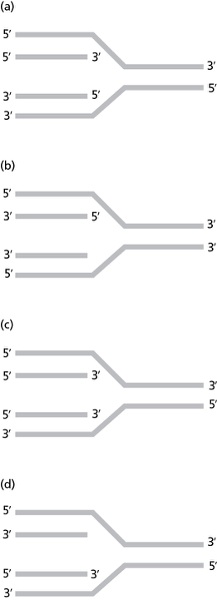
Which diagram accurately represents the directionality of DNA strands at one side of a replication fork?
D
Primase is needed to initiate DNA replication on both the leading strand and the lagging strand.
true or false
true
The sliding clamp is loaded once on each DNA strand, where it remains associated until replication is complete.
true or false
False. Although the sliding clamp is only loaded once on the leading strand, the lagging strand needs to unload the clamp once the polymerase reaches the RNA primer from the previous segment and then reload it where a new primer has been synthesized.
Telomerase is a DNA polymerase that carries its own RNA molecule to use as a primer at the end of the lagging strand.
true or false
true
Primase requires a proofreading function that ensures there are no errors in the RNA primers used for DNA replication.
true or false
False. Primase does not have a proofreading function, nor does it need one because the RNA primers are not a permanent part of the DNA. The primers are removed, and a DNA polymerase that does have a proofreading function fills in the remaining gaps.
DNA polymerases are processive, which means that they remain tightly associated with the template strand while moving rapidly and adding nucleotides to the growing daughter strand. Which piece of the replication machinery accounts for this characteristic?
(a) helicase
(b) sliding clamp
(c) single-strand binding protein
(d) primase
(b) sliding clamp
The repair polymerase is the enzyme that proofreads the newly synthesized strands to ensure the accuracy of DNA replication.
true or false
False. The repair polymerase is used to fill in the spaces left vacant after the RNA primers are degraded.
There is a single enzyme that degrades the RNA primers and lays down the corresponding DNA sequence behind it.
true or false
False. This is a two-step process that requires two different enzymes. First, a nuclease removes the RNA primers. Then, the repair polymerase fills in the complementary DNA sequence.
DNA ligase is required to seal the sugar–phosphate backbone between all the DNA fragments on the lagging strand.
true or false
true
The repair polymerase does not require the aid of the sliding clamp, because it is only synthesizing DNA over very short stretches.
true or false
true
Which of the following statements about sequence proofreading during DNA replication is false?
(a) The exonuclease activity is in a different domain of the DNA polymerase.
(b) The exonuclease activity cleaves DNA in the 5′-to-3′ direction.
(c) The DNA proofreading activity occurs concomitantly with strand elongation.
(d) If an incorrect base is added, it is “unpaired” before removal.
(b) The exonuclease activity cleaves DNA in the 5′-to-3′ direction.
The DNA duplex consists of two long covalent polymers wrapped around each other many times over their entire length. The separation of the DNA strands for replication causes the strands to be “overwound” in front of the replication fork. How does the cell relieve the torsional stress created along the DNA duplex during replication?
(a) Nothing needs to be done because the two strands will be separated after replication is complete.
(b) Topoisomerases break the covalent bonds of the backbone allowing the local unwinding of DNA ahead of the replication fork.
(c) Helicase unwinds the DNA and rewinds it after replication is complete.
(d) DNA repair enzymes remove torsional stress as they replace incorrectly paired bases.
(b) Topoisomerases break the covalent bonds of the backbone allowing the local unwinding of DNA ahead of the replication fork.
Telomeres serve as caps at the ends of linear chromosomes. Which of the following is not true regarding the replication of telomeric sequences?
(a) The lagging-strand telomeres are not completely replicated by DNA polymerase.
(b) Telomeres are made of repeating sequences.
(c) Additional repeated sequences are added to the template strand.
(d) The leading strand doubles back on itself to form a primer for the lagging strand.
(d) The leading strand doubles back on itself to form a primer for the lagging strand.
Sickle-cell anemia is an example of an inherited disease. Individuals with this disorder have misshapen (sickle-shaped) red blood cells caused by a change in the sequence of the β-globin gene. What is the nature of the change?
(a) chromosome loss
(b) base-pair change
(c) gene duplication
(d) base-pair insertion
(b) base-pair change
Even though DNA polymerase has a proofreading function, it still introduces errors in the newly synthesized strand at a rate of 1 per 107 nucleotides. To what degree does the mismatch repair system decrease the error rate arising from DNA replication?
(a) 2-fold
(b) 5-fold
(c) 10-fold
(d) 100-fold
(d) 100-fold

Which of the choices below represents the correct way to repair the mismatch shown in Figure Q6-41?
(answers on back)
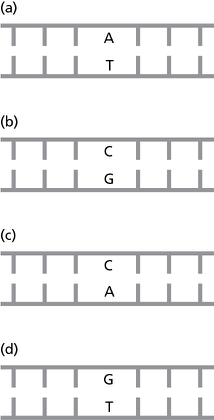
A
Beside the distortion in the DNA backbone caused by a mismatched base pair, what additional mark is there on eukaryotic DNA to indicate which strand needs to be repaired?
(a) a nick in the template strand
(b) a chemical modification of the new strand
(c) a nick in the new strand
(d) a sequence gap in the new strand
(c) a nick in the new strand
A pregnant mouse is exposed to high levels of a chemical. Many of the mice in her litter are deformed, but when they are interbred with each other, all their offspring are normal. Which two of the following statements could explain these results?
(a) In the deformed mice, somatic cells but not germ cells were mutated.
(b) The original mouse’s germ cells were mutated.
(c) In the deformed mice, germ cells but not somatic cells were mutated.
(d) The toxic chemical affects development but is not mutagenic.
(a) In the deformed mice, somatic cells but not germ cells were mutated.
or
(d) The toxic chemical affects development but is not mutagenic.
The repair of mismatched base pairs or damaged nucleotides in a DNA strand requires a multistep process. Which choice below describes the known sequence of events in this process?
(a) DNA damage is recognized, the newly synthesized strand is identified by an existing nick in the backbone, a segment of the new strand is removed by repair proteins, the gap is filled by DNA polymerase, and the strand is sealed by DNA ligase.
(b) DNA repair polymerase simultaneously removes bases ahead of it and polymerizes the correct sequence behind it as it moves along the template. DNA ligase seals the nicks in the repaired strand.
(c) DNA damage is recognized, the newly synthesized strand is identified by an existing nick in the backbone, a segment of the new strand is removed by an exonuclease, and the gap is repaired by DNA ligase.
(d) A nick in the DNA is recognized, DNA repair proteins switch out the wrong base and insert the correct base, and DNA ligase seals the nick.
(a) DNA damage is recognized, the newly synthesized strand is identified by an existing nick in the backbone, a segment of the new strand is removed by repair proteins, the gap is filled by DNA polymerase, and the strand is sealed by DNA ligase.
Human beings with the inherited disease xeroderma pigmentosum have serious problems with lesions on their skin and often develop skin cancer with repeated exposure to sunlight. What type of DNA damage is not being recognized in the cells of these individuals?
(a) chemical damage
(b) X-ray irradiation damage
(c) mismatched bases
(d) ultraviolet irradiation damage
(d) ultraviolet irradiation damage
You are examining the DNA sequences that code for the enzyme phosphofructokinase in skinks and Komodo dragons. You notice that the coding sequence that actually directs the sequence of amino acids in the enzyme is very similar in the two organisms but that the surrounding sequences vary quite a bit. What is the most likely explanation for this?
(a) Coding sequences are repaired more efficiently.
(b) Coding sequences are replicated more accurately.
(c) Coding sequences are packaged more tightly in the chromosomes to protect them from DNA damage.
(d) Mutations in coding sequences are more likely to be deleterious to the organism than mutations in noncoding sequences.
(d) Mutations in coding sequences are more likely to be deleterious to the organism than mutations in noncoding sequences.
In somatic cells, if a base is mismatched in one new daughter strand during DNA replication, and is not repaired, what fraction of the DNA duplexes will have a permanent change in the DNA sequence after the second round of DNA replication?
(a) 1/2
(b) 1/4
(c) 1/8
(d) 1/16
(b) 1/4
Sometimes, chemical damage to DNA can occur just before DNA replication begins, not giving the repair system enough time to correct the error before the DNA is duplicated. This gives rise to mutation. If the cytosine in the sequence TCAT is deaminated and not repaired, which of the following is the point mutation you would observe after this segment has undergone two rounds of DNA replication?
(a) TTAT
(b) TUAT
(c) TGAT
(d) TAAT
(a) TTAT
Sometimes, chemical damage to DNA can occur just before DNA replication begins, not giving the repair system enough time to correct the error before the DNA is duplicated. This gives rise to mutation. If the adenosine in the sequence TCAT is depurinated and not repaired, which of the following is the point mutation you would observe after this segment has undergone two rounds of DNA replication?
(a) TCGT
(b) TAT
(c) TCT
(d) TGTT
(c) TCT
Which of the following statements is not an accurate statement about thymine dimers?
(a) Thymine dimers can cause the DNA replication machinery to stall.
(b) Thymine dimers are covalent links between thymidines on opposite DNA strands.
(c) Prolonged exposure to sunlight causes thymine dimers to form.
(d) Repair proteins recognize thymine dimers as a distortion in the DNA backbone.
(b) Thymine dimers are covalent links between thymidines on opposite DNA strands.
Ionizing radiation and oxidative damage can cause DNA double-strand breaks.
true or false
true
After damaged DNA has been repaired, nicks in the phosphate backbone are maintained as a way to identify the strand that was repaired.
true or false
False. It is believed that the nicks are generated during DNA replication as a means of easy identification of the newly synthesized strand but are sealed by DNA ligase shortly after replication is completed.
Depurination of DNA is a rare event that is caused by ultraviolet irradiation.
true or false
False. Depurination occurs constantly in our cells through spontaneous hydrolysis of the bond linking the DNA base to the deoxyribose sugar.
Nonhomologous end joining is a mechanism that ensures that DNA double-strand breaks are repaired with a high degree of fidelity to the original DNA sequence.
true or false
False. Homologous recombination can repair double-strand breaks without any change in DNA sequence, but nonhomologous end joining always involves a loss of genetic information because the ends are degraded by nucleases before they can be ligated back together.
Several members of the same family were diagnosed with the same kind of cancer when they were unusually young. Which one of the following is the most likely explanation for this phenomenon? It is possible that the individuals with the cancer have _______________________.
(a) inherited a cancer-causing gene that suffered a mutation in an ancestor’s somatic cells.
(b) inherited a mutation in a gene required for DNA synthesis.
(c) inherited a mutation in a gene required for mismatch repair.
(d) inherited a mutation in a gene required for the synthesis of purine nucleotides.
(c) inherited a mutation in a gene required for mismatch repair.
Select the option that best completes the following statement: Nonhomologous end joining is a process by which a double-stranded DNA end is joined ___________________.
(a) to a similar stretch of sequence on the complementary chromosome.
(b) after repairing any mismatches.
(c) to the nearest available double-stranded DNA end.
(d) after filling in any lost nucleotides, helping to maintain the integrity of the DNA sequence.
(c) to the nearest available double-stranded DNA end.
Nonhomologous end joining can result in all but which of the following?
(a) the recovery of lost nucleotides on a damaged DNA strand
(b) the interruption of gene expression
(c) loss of nucleotides at the site of repair
(d) translocations of DNA fragments to an entirely different chromosome
(a) the recovery of lost nucleotides on a damaged DNA strand
Homologous recombination is an important mechanism in which organisms use a “backup” copy of the DNA as a template to fix double-strand breaks without loss of genetic information. Which of the following is not necessary for homologous recombination to occur?
(a) 3′ DNA strand overhangs
(b) 5′ DNA strand overhangs
(c) a long stretch of sequence similarity
(d) nucleases
(b) 5′ DNA strand overhangs
In addition to the repair of DNA double-strand breaks, homologous recombination is a mechanism for generating genetic diversity by swapping segments of parental chromosomes. During which process does swapping occur?
(a) DNA replication
(b) DNA repair
(c) meiosis
(d) transposition
(c) meiosis
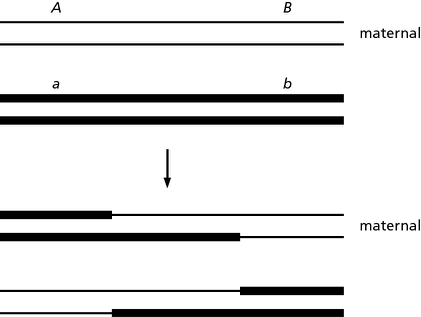
Recombination has occurred between the chromosome segments shown in Figure Q6-61. The genes A and B, and the recessive alleles a and b, are used as markers on the maternal and paternal chromosomes, respectively. After alignment and homologous recombination, the specific arrangements of A, B, a, and b have changed.
Which of the choices below correctly indicates the gene combination from the replication products of the maternal chromosome?
(a) AB and aB
(b) ab and Ab
(c) AB and Ab
(d) aB and Ab
(d) aB and Ab
The events listed below are all necessary for homologous recombination to occur properly:
- Holliday junction cut and ligated
- strand invasion
- DNA synthesis
- DNA ligation
- double-strand break
- nucleases create uneven strands
Which of the following is the correct order of events during homologous recombination?
(a) E, B, F, D, C, A
(b) B, E, F, D, C, A
(c) C, E, F, B, D, A
(d) E, F, B, C, D, A
(d) E, F, B, C, D, A
Homologous recombination cannot occur in prokaryotic cells, because they are haploid, and therefore have no extra copy of the chromosome to use as a template for repair.
true or false
False. Homologous recombination also occurs in prokaryotic cells, and typically occurs very shortly after DNA replication, when the newly replicated duplexes are in close proximity.
The first step in repair requires a nuclease to remove a stretch of base pairs from the 5′ end of each strand at the site of the break.
true or false
true
The 3′ overhang “invades” the homologous DNA duplex, which can be used as a primer for the repair DNA polymerase.
true or false
true
The DNA template used to repair the broken strand is the homologous chromosome inherited from the other parent.
true or false
False. Although it is called homologous recombination, this is not a process that depends on the proximity of parental homologs. When used as a mechanism for DNA repair, homologous recombination uses the sister chromatids in an undamaged, newly replicated (homologous) DNA helix as a template.
RNA in cells differs from DNA in that ___________________.
(a) it contains the base uracil, which pairs with cytosine.
(b) it is single-stranded and cannot form base pairs.
(c) it is single-stranded and can fold up into a variety of structures.
(d) the sugar ribose contains fewer oxygen atoms than does deoxyribose.
(c) it is single-stranded and can fold up into a variety of structures.
Transcription is similar to DNA replication in that ___________________.
(a) an RNA transcript is synthesized discontinuously and the pieces are then joined together.
(b) it uses the same enzyme as that used to synthesize RNA primers during DNA replication.
(c) the newly synthesized RNA remains paired to the template DNA.
(d) nucleotide polymerization occurs only in the 5′-to-3′ direction.
(d) nucleotide polymerization occurs only in the 5′-to-3′ direction.
Which of the following statements is false?
(a) A new RNA molecule can begin to be synthesized from a gene before the previous RNA molecule’s synthesis is completed.
(b) If two genes are to be expressed in a cell, these two genes can be transcribed with different efficiencies.
(c) RNA polymerase is responsible for both unwinding the DNA helix and catalyzing the formation of the phosphodiester bonds between nucleotides.
(d) Unlike DNA, RNA uses a uracil base and a deoxyribose sugar.
(d) Unlike DNA, RNA uses a uracil base and a deoxyribose sugar.
Unlike DNA, which typically forms a helical structure, different molecules of RNA can fold into a variety of three-dimensional shapes. This is largely because ___________________.
(a) RNA contains uracil and uses ribose as the sugar.
(b) RNA bases cannot form hydrogen bonds with each other.
(c) RNA nucleotides use a different chemical linkage between nucleotides compared to DNA.
(d) RNA is single-stranded.
(d) RNA is single-stranded.
Which of the following molecules of RNA would you predict to be the most likely to fold into a specific structure as a result of intramolecular base-pairing?
(a) 5′-CCCUAAAAAAAAAAAAAAAAUUUUUUUUUUUUUUUUAGGG-3′
(b) 5′-UGUGUGUGUGUGUGUGUGUGUGUGUGUGUGUGUGUGUGUG-3′
(c) 5′-AAAAAAAAAAAAAAAAAAAAAAAAAAAAAAAAAAAAAAAA-3′
(d) 5′-GGAAAAGGAGAUGGGCAAGGGGAAAAGGAGAUGGGCAAGG-3′
(a) 5′-CCCUAAAAAAAAAAAAAAAAUUUUUUUUUUUUUUUUAGGG-3′
Which one of the following is the main reason that a typical eukaryotic gene is able to respond to a far greater variety of regulatory signals than a typical prokaryotic gene or operon?
(a) Eukaryotes have three types of RNA polymerase.
(b) Eukaryotic RNA polymerases require general transcription factors.
(c) The transcription of a eukaryotic gene can be influenced by proteins that bind far from the promoter.
(d) Prokaryotic genes are packaged into nucleosomes.
(c) The transcription of a eukaryotic gene can be influenced by proteins that bind far from the promoter.
You have a piece of DNA that includes the following sequence:
5′-ATAGGCATTCGATCCGGATAGCAT-3′
3′-TATCCGTAAGCTAGGCCTATCGTA-5′
Which of the following RNA molecules could be transcribed from this piece of DNA?
(a) 5′-UAUCCGUAAGCUAGGCCUAUGCUA-3′
(b) 5′-AUAGGCAUUCGAUCCGGAUAGCAU-3′
(c) 5′-UACGAUAGGCCUAGCUUACGGAUA-3′
(d) none of the above
(b) 5′-AUAGGCAUUCGAUCCGGAUAGCAU-3′
You have a segment of DNA that contains the following sequence:
5′-GGACTAGACAATAGGGACCTAGAGATTCCGAAA-3′
3′-CCTGATCTGTTATCCCTGGATCTCTAAGGCTTT-5′
You know that the RNA transcribed from this segment contains the following sequence:
5′-GGACUAGACAAUAGGGACCUAGAGAUUCCGAAA–3′
Which of the following choices best describes how transcription occurs?
(a) the top strand is the template strand; RNA polymerase moves along this strand from 5′ to 3′
(b) the top strand is the template strand; RNA polymerase moves along this strand from 3′ to 5′
(c) the bottom strand is the template strand; RNA polymerase moves along this strand from 5′ to 3′
(d) the bottom strand is the template strand; RNA polymerase moves along this strand from 3′ to 5′
(d) the bottom strand is the template strand; RNA polymerase moves along this strand from 3′ to 5′
The sigma subunit of bacterial RNA polymerase ___________________.
(a) contains the catalytic activity of the polymerase.
(b) remains part of the polymerase throughout transcription.
(c) recognizes promoter sites in the DNA.
(d) recognizes transcription termination sites in the DNA.
(c) recognizes promoter sites in the DNA.
Which of the following might decrease the transcription of only one specific gene in a bacterial cell?
(a) a decrease in the amount of sigma factor
(b) a decrease in the amount of RNA polymerase
(c) a mutation that introduced a stop codon into the DNA that precedes the gene’s coding sequence
(d) a mutation that introduced extensive sequence changes into the DNA that precedes the gene’s transcription start site
(d) a mutation that introduced extensive sequence changes into the DNA that precedes the gene’s transcription start site
There are several reasons why the primase used to make the RNA primer for DNA replication is not suitable for gene transcription. Which of the statements below is not one of those reasons?
(a) Primase initiates RNA synthesis on a single-stranded DNA template.
(b) Primase can initiate RNA synthesis without the need for a base-paired primer.
(c) Primase synthesizes only RNAs of about 5–20 nucleotides in length.
(d) The RNA synthesized by primase remains base-paired to the DNA template.
(b) Primase can initiate RNA synthesis without the need for a base-paired primer.
You have a bacterial strain with a mutation that removes the transcription termination signal from the Abd operon. Which of the following statements describes the most likely effect of this mutation on Abd transcription?
(a) The Abd RNA will not be produced in the mutant strain.
(b) The Abd RNA from the mutant strain will be longer than normal.
(c) Sigma factor will not dissociate from RNA polymerase when the Abd operon is being transcribed in the mutant strain.
(d) RNA polymerase will move in a backward fashion at the Abd operon in the mutant strain.
(b) The Abd RNA from the mutant strain will be longer than normal.
Transcription in bacteria differs from transcription in a eukaryotic cell because __________________________.
(a) RNA polymerase (along with its sigma subunit) can initiate transcription on its own.
(b) RNA polymerase (along with its sigma subunit) requires the general transcription factors to assemble at the promoter before polymerase can begin transcription.
(c) the sigma subunit must associate with the appropriate type of RNA polymerase to produce mRNAs.
(d) RNA polymerase must be phosphorylated at its C-terminal tail for transcription to proceed.
(a) RNA polymerase (along with its sigma subunit) can initiate transcription on its own.
Which of the following does not occur before a eukaryotic mRNA is exported from the nucleus?
(a) The ribosome binds to the mRNA.
(b) The mRNA is polyadenylated at its 3′ end.
(c) 7-methylguanosine is added in a 5′-to-5′ linkage to the mRNA.
(d) RNA polymerase dissociates.
(a) The ribosome binds to the mRNA.
Total nucleic acids are extracted from a culture of yeast cells and are then mixed with resin beads to which the polynucleotide 5′-TTTTTTTTTTTTTTTTTTTTTTTTT-3′ has been covalently attached. After a short incubation, the beads are then extracted from the mixture. When you analyze the cellular nucleic acids that have stuck to the beads, which of the following is most abundant?
(a) DNA
(b) tRNA
(c) rRNA
(d) mRNA
(d) mRNA
Which of the following statements about RNA splicing is false?
(a) Conventional introns are not found in bacterial genes.
(b) For a gene to function properly, every exon must be removed from the primary transcript in the same fashion on every mRNA molecule produced from the same gene.
(c) Small RNA molecules in the nucleus perform the splicing reactions necessary for the removal of introns.
(d) Splicing occurs after the 5′ cap has been added to the end of the primary transcript.
(b) For a gene to function properly, every exon must be removed from the primary transcript in the same fashion on every mRNA molecule produced from the same gene.
Genes in eukaryotic cells often have intronic sequences coded for within the DNA. These sequences are ultimately not translated into proteins. Why?
(a) Intronic sequences are removed from RNA molecules by the spliceosome, which works in the nucleus.
(b) Introns are not transcribed by RNA polymerase.
(c) Introns are removed by catalytic RNAs in the cytoplasm.
(d) The ribosome will skip over intron sequences when translating RNA into protein.
(a) Intronic sequences are removed from RNA molecules by the spliceosome, which works in the nucleus.
Which of the following statements about the genetic code is correct?
(a) All codons specify more than one amino acid.
(b) The genetic code is redundant.
(c) All amino acids are specified by more than one codon.
(d) All codons specify an amino acid.
(b) The genetic code is redundant.
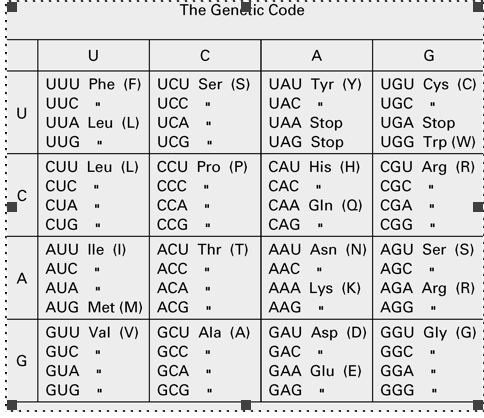
The piece of RNA below includes the region that codes for the binding site for the initiator tRNA needed in translation.
5′-GUUUCCCGUAUACAUGCGUGCCGGGGGC-3′
Which amino acid will be on the tRNA that is the first to bind to the A site of the ribosome?
(a) methionine
(b) arginine
(c) cysteine
(d) valine
(b) arginine
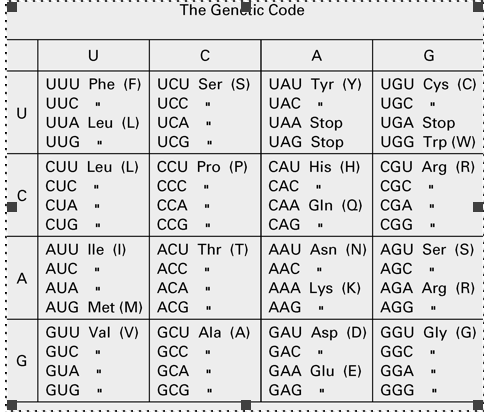
Which amino acid would you expect a tRNA with the anticodon 5′-CUU-3′ to carry?
(a) lysine
(b) glutamic acid
(d) leucine
(d) phenylalanine
(a) lysine
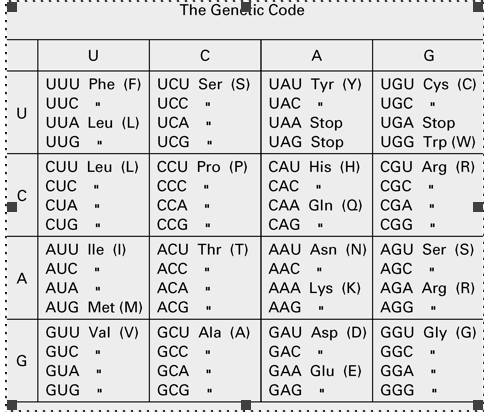
Which of the following pairs of codons might you expect to be read by the same tRNA as a result of wobble?
(a) CUU and UUU
(b) GAU and GAA
(c) CAC and CAU
(d) AAU and AGU
(c) CAC and CAU
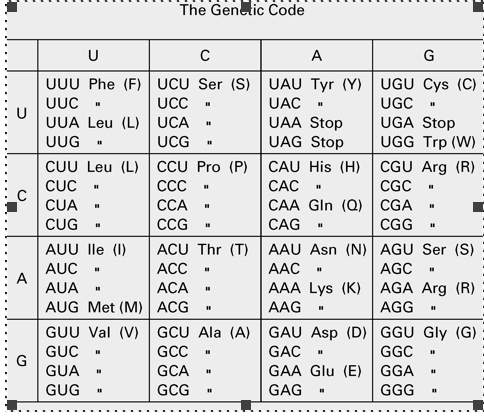
Below is the sequence from the 3′ end of an mRNA.
5′-CCGUUACCAGGCCUCAUUAUUGGUAACGGAAAAAAAAAAAAAA-3′
If you were told that this sequence contains the stop codon for the protein encoded by this mRNA, what is the anticodon on the tRNA in the P site of the ribosome when release factor binds to the A site?
(a) 5′-CCA-3′
(b) 5′-CCG-3′
(c) 5′-UGG-3′
(d) 5′-UUA-3′
(a) 5′-CCA-3′
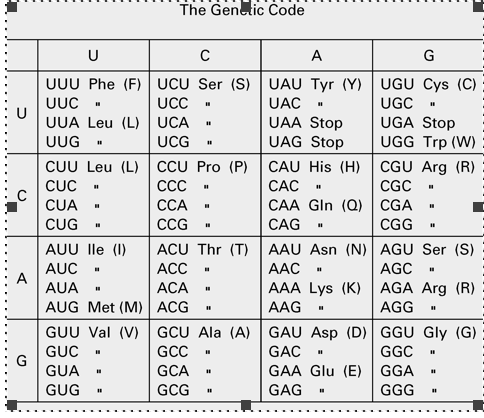
A mutation in the tRNA for the amino acid lysine results in the anticodon sequence 5′-UAU-3′ (instead of 5′-UUU-3′). Which of the following aberrations in protein synthesis might this tRNA cause?
(a) read-through of stop codons
(b) substitution of lysine for isoleucine
(c) substitution of lysine for tyrosine
(d) substitution of lysine for phenylalanine
(b) substitution of lysine for isoleucine
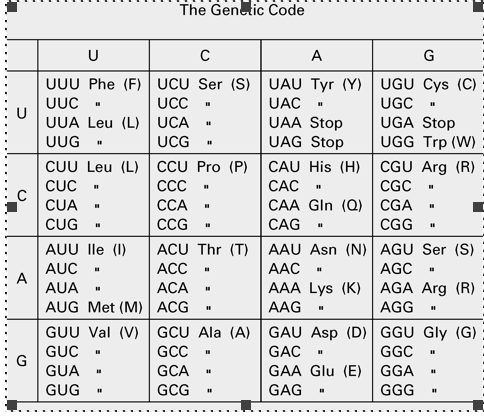
What do you predict would happen if you created a tRNA with an anticodon of 5′-CAA-3′ that is charged with methionine, and added this modified tRNA to a cell-free translation system that has all the normal components required for translating RNAs?
(a) methionine would be incorporated into proteins at some positions where glutamine should be
(b) methionine would be incorporated into proteins at some positions where leucine should be
(c) methionine would be incorporated into proteins at some positions where valine should be
(d) translation would no longer be able to initiate
(b) methionine would be incorporated into proteins at some positions where leucine should be
The ribosome is important for catalyzing the formation of peptide bonds. Which of the following statements is true?
(a) The number of rRNA molecules that make up a ribosome greatly exceeds the number of protein molecules found in the ribosome.
(b) The large subunit of the ribosome is important for binding to the mRNA.
(c) The catalytic site for peptide bond formation is formed primarily from an rRNA.
(d) Once the large and small subunits of the ribosome assemble, they will not separate from each other until degraded by the proteasome.
(c) The catalytic site for peptide bond formation is formed primarily from an rRNA.
Which of the following statements is true?
(a) Ribosomes are large RNA structures composed solely of rRNA.
(b) Ribosomes are synthesized entirely in the cytoplasm.
(c) rRNA contains the catalytic activity that joins amino acids together.
(d) A ribosome binds one tRNA at a time.
(c) rRNA contains the catalytic activity that joins amino acids together.
A poison added to an in vitro translation mixture containing mRNA molecules with the sequence 5′-AUGAAAAAAAAAAAAUAA-3′ has the following effect: the only product made is a Met-Lys dipeptide that remains attached to the ribosome. What is the most likely way in which the poison acts to inhibit protein synthesis?
(a) It inhibits peptidyl transferase activity.
(b) It inhibits movement of the small subunit relative to the large subunit.
(c) It inhibits release factor.
(d) It mimics release factor.
(b) It inhibits movement of the small subunit relative to the large subunit.
In eukaryotes, but not in prokaryotes, ribosomes find the start site of translation by ____________________________.
(a) binding directly to a ribosome-binding site preceding the initiation codon.
(b) scanning along the mRNA from the 5′ end.
(c) recognizing an AUG codon as the start of translation.
(d) binding an initiator tRNA.
(b) scanning along the mRNA from the 5′ end.
Which of the following statements about prokaryotic mRNA molecules is false?
(a) A single prokaryotic mRNA molecule can be translated into several proteins.
(b) Ribosomes must bind to the 5′ cap before initiating translation.
(c) mRNAs are not polyadenylated.
(d) Ribosomes can start translating an mRNA molecule before transcription is complete.
(b) Ribosomes must bind to the 5′ cap before initiating translation.
The concentration of a particular protein, X, in a normal human cell rises gradually from a low point, immediately after cell division, to a high point, just before cell division, and then drops sharply. The level of its mRNA in the cell remains fairly constant throughout this time. Protein X is required for cell growth and survival, but the drop in its level just before cell division is essential for division to proceed. You have isolated a line of human cells that grow in size in culture but cannot divide, and on analyzing these mutants, you find that levels of X mRNA in the mutant cells are normal. Which of the following mutations in the gene for X could explain these results?
(a) the introduction of a stop codon that truncates protein X at the fourth amino acid
(b) a change of the first ATG codon to CCA
(c) the deletion of a sequence that encodes sites at which ubiquitin can be attached to the protein
(d) a change at a splice site that prevents splicing of the RNA
(c) the deletion of a sequence that encodes sites at which ubiquitin can be attached to the protein
Which of the following methods is not used by cells to regulate the amount of a protein in the cell?
(a) Genes can be transcribed into mRNA with different efficiencies.
(b) Many ribosomes can bind to a single mRNA molecule.
(c) Proteins can be tagged with ubiquitin, marking them for degradation.
(d) Nuclear pore complexes can regulate the speed at which newly synthesized proteins are exported from the nucleus into the cytoplasm.
(d) Nuclear pore complexes can regulate the speed at which newly synthesized proteins are exported from the nucleus into the cytoplasm.
Which of the following statements about the proteasome is false?
(a) Ubiquitin is a small protein that is covalently attached to proteins to mark them for delivery to the proteasome.
(b) Proteases reside in the central cylinder of a proteasome.
(c) Misfolded proteins are delivered to the proteasome, where they are sequestered from the cytoplasm and can attempt to refold.
(d) The protein stoppers that surround the central cylinder of the proteasome use the energy from ATP hydrolysis to move proteins into the proteasome inner chamber.
(c) Misfolded proteins are delivered to the proteasome, where they are sequestered from the cytoplasm and can attempt to refold.
Which of the following molecules is thought to have arisen first during evolution?
(a) protein
(b) DNA
(c) RNA
(d) all came to be at the same time
(c) RNA
According to current thinking, the minimum requirement for life to have originated on Earth was the formation of a _______________.
(a) molecule that could provide a template for the production of a complementary molecule.
(b) double-stranded DNA helix.
(c) molecule that could direct protein synthesis.
(d) molecule that could catalyze its own replication.
(d) molecule that could catalyze its own replication.
Ribozymes catalyze which of the following reactions?
(a) DNA synthesis
(b) transcription
(c) RNA splicing
(d) protein hydrolysis
(c) RNA splicing
You are studying a disease that is caused by a virus, but when you purify the virus particles and analyze them you find they contain no trace of DNA. Which of the following molecules are likely to contain the genetic information of the virus?
(a) high-energy phosphate groups
(b) RNA
(c) lipids
(d) carbohydrates
(b) RNA
When using a repeating trinucleotide sequence (such as 5′-AAC-3′) in a cell-free translation system, you will obtain:
(a) three different types of peptides, each made up of a single amino acid
(b) peptides made up of three different amino acids in random order
(c) peptides made up of three different amino acids, each alternating with each other in a repetitive fashion
(d) polyasparagine, as the codon for asparagine is AAC
(a) three different types of peptides, each made up of a single amino acid
A neuron and a white blood cell have very different functions. For example, a neuron can receive and respond to electrical signals while a white blood cell defends the body against infection. This is because ______.
(a) the proteins found in a neuron are completely different from the proteins found in a white blood cell.
(b) the neuron and the white blood cell within an individual have the same genome.
(c) the neuron expresses some mRNAs that the white blood cell does not.
(d) neurons and white blood cells are differentiated cells and thus no longer need to transcribe and translate genes.
(c) the neuron expresses some mRNAs that the white blood cell does not.
The distinct characteristics of different cell types in a multicellular organism result mainly from the differential regulation of the _________________.
(a) replication of specific genes.
(b) transcription of genes transcribed by RNA polymerase II.
(c) transcription of housekeeping genes.
(d) proteins that directly bind the TATA box of eukaryotic genes.
(b) transcription of genes transcribed by RNA polymerase II.
The human genome encodes about 21,000 protein-coding genes. Approximately how many such genes does the typical differentiated human cell express at any one time?
(a) 21,000—all of them
(b) between 18,900 and 21,000—at least 90% of the genes
(c) between 5000 and 15,000
(d) less than 2100
(c) between 5000 and 15,000
Which of the following is not a good example of a housekeeping protein?
(a) DNA repair enzymes
(b) histones
(c) ATP synthase
(d) hemoglobin
(d) hemoglobin
Which of the following statements about differentiated cells is true?
(a) Cells of distinct types express nonoverlapping sets of transcription factors.
(b) Once a cell has differentiated, it can no longer change its gene expression.
(c) Once a cell has differentiated, it will no longer need to transcribe RNA.
(d) Some of the proteins found in differentiated cells are found in all cells of a multicellular organism.
(d) Some of the proteins found in differentiated cells are found in all cells of a multicellular organism.
Investigators performed nuclear transplant experiments to determine whether DNA is altered irreversibly during development. Which of the following statements about these experiments is true?
(a) Because the donor nucleus is taken from an adult animal, the chromosomes from the nucleus must undergo recombination with the DNA in the egg for successful development to occur.
(b) The embryo that develops from the nuclear transplant experiment is genetically identical to the donor of the nucleus.
(c) The meiotic spindle of the egg must interact with the chromosomes of the injected nuclei for successful nuclear transplantation to occur.
(d) Although nuclear transplantation has been successful in producing embryos in some mammals with the use of foster mothers, evidence of DNA alterations during differentiation has not been obtained for plants.
(b) The embryo that develops from the nuclear transplant experiment is genetically identical to the donor of the nucleus.
Which of these method(s) of controlling eukaryotic gene expression is NOT employed in prokaryotic cells?
A. controlling how often a gene is transcribed
B. controlling how an RNA transcript is spliced
C. controlling which mRNAs are exported from the nucleus to the cytosol
D. controlling which mRNAs are translated into protein by the ribosomes
E. controlling how rapidly proteins are destroyed once they are made
B, C
Which of the following statements about transcriptional regulators is false?
(a) Transcriptional regulators usually interact with the sugar–phosphate backbone on the outside of the double helix to determine where to bind on the DNA helix.
(b) Transcriptional regulators will form hydrogen bonds, ionic bonds, and hydrophobic interactions with DNA.
(c) The DNA-binding motifs of transcriptional regulators usually bind in the major groove of the DNA helix.
(d) The binding of transcriptional regulators generally does not disrupt the hydrogen bonds that hold the double helix together.
(a) Transcriptional regulators usually interact with the sugar–phosphate backbone on the outside of the double helix to determine where to bind on the DNA helix.
Operons ___________________________.
(a) are commonly found in eukaryotic cells.
(b) are transcribed by RNA polymerase II.
(c) contain a cluster of genes transcribed as a single mRNA.
(d) can only be regulated by gene activator proteins.
(c) contain a cluster of genes transcribed as a single mRNA.
The tryptophan operator ___________________________.
(a) is an allosteric protein.
(b) binds to the tryptophan repressor when the repressor is bound to tryptophan.
(c) is required for production of the mRNA encoded by the tryptophan operon.
(d) is important for the production of the tryptophan repressor.
(b) binds to the tryptophan repressor when the repressor is bound to tryptophan.
Which of the following statements about the Lac operon is false?
(a) The Lac repressor binds when lactose is present in the cell.
(b) Even when the CAP activator is bound to DNA, if lactose is not present, the Lac operon will not be transcribed.
(c) The CAP activator can only bind DNA when it is bound to cAMP.
(d) The Lac operon only produces RNA when lactose is present and glucose is absent.
(a) The Lac repressor binds when lactose is present in the cell.
What do you predict would happen if you replace the Lac operator DNA from the Lac operon with the DNA from the operator region from the tryptophan operon?
(a) The presence of lactose will not cause allosteric changes to the Lac repressor.
(b) The Lac operon will not be transcribed when tryptophan levels are high.
(c) The lack of glucose will no longer allow CAP binding to the DNA.
(d) RNA polymerase will only bind to the Lac promoter when lactose is present.
(b) The Lac operon will not be transcribed when tryptophan levels are high.
How are most eukaryotic transcription regulators able to affect transcription when their binding sites are far from the promoter?
(a) by binding to their binding site and sliding to the site of RNA polymerase assembly
(b) by looping out the intervening DNA between their binding site and the promoter
(c) by unwinding the DNA between their binding site and the promoter
(d) by attracting RNA polymerase and modifying it before it can bind to the promoter
(b) by looping out the intervening DNA between their binding site and the promoter
Which of the following statements about nucleosomes is true?
(a) Nucleosomes activate transcription when bound to the promoter.
(b) Although RNA polymerase can access DNA packed within nucleosomes, the general transcription factors and transcriptional regulators cannot.
(c) Histone acetyltransferases affect transcription by both altering chromatin structure to allow accessibility to the DNA and by adding acetyl groups to histones that can bind proteins that promote transcription.
(d) Histone deacetylases remove lysines from histone tails.
(c) Histone acetyltransferases affect transcription by both altering chromatin structure to allow accessibility to the DNA and by adding acetyl groups to histones that can bind proteins that promote transcription.
In principle, how many different cell types can an organism having four different types of transcription regulator and thousands of genes create?
(a) up to 4
(b) up to 8
(c) up to 16
(d) thousands
(c) up to 16
Combinatorial control of gene expression __________________________.
(a) involves every gene using a different combination of transcriptional regulators for its proper expression.
(b) involves groups of transcriptional regulators working together to determine the expression of a gene.
(c) involves only the use of gene activators used together to regulate genes appropriately.
(d) is seen only when genes are arranged in operons.
(b) involves groups of transcriptional regulators working together to determine the expression of a gene.
You are studying a set of mouse genes whose expression increases when cells are exposed to the hormone cortisol, and you believe that the same cortisol-responsive transcriptional activator regulates all of these genes. Which of the following statements below should be true if your hypothesis is correct?
(a) The cortisol-responsive genes share a DNA sequence in their regulatory regions that binds the cortisol-responsive transcriptional activator.
(b) The cortisol-responsive genes must all be in an operon.
(c) The transcriptional regulators that bind to the regulatory regions of the cortisol-responsive genes must all be the same.
(d) The cortisol-responsive genes must not be transcribed in response to other hormones.
(a) The cortisol-responsive genes share a DNA sequence in their regulatory regions that binds the cortisol-responsive transcriptional activator.
Which of the following statements about iPS cells is false?
(a) iPS cells are created by adding a combination of transcription regulators to a fibroblast.
(b) iPS cells created from mouse cells can differentiate into almost any human cell type.
(c) Stimulation by extracellular signal molecules causes iPS cells to differentiate.
(d) During the de-differentiation process to become an iPS, the fibroblast will undergo changes to its gene expression profile.
(b) iPS cells created from mouse cells can differentiate into almost any human cell type.
Which of the following statements about how fruit flies can develop an eye in the middle of a leg is true?
(a) When the Ey gene is expressed in adult leg cells, these cells de-differentiate and become eye cells.
(b) The Ey gene encodes a transcription regulator that is the only transcription regulator used to produce a fruit-fly eye.
(c) When the Ey gene is introduced into cells that would normally give rise to a leg, the transcription regulators used to control its expression in the leg are different from those that are normally used to control Ey expression in the eye.
(d) All the eye cells found in the adult leg are a single cell type and have identical characteristics.
(c) When the Ey gene is introduced into cells that would normally give rise to a leg, the transcription regulators used to control its expression in the leg are different from those that are normally used to control Ey expression in the eye.
Which of the following statements about the Ey transcriptional regulator is false?
(a) Expression of Ey in cells that normally form legs in the fly will lead to the formation of an eye in the middle of the legs.
(b) The Ey transcription factor must bind to the promoter of every eye-specific gene in the fly.
(c) Positive feedback loops ensure that Ey expression remains switched on in the developing eye.
(d) A homolog of Ey is found in vertebrates; this homolog is also used during eye development.
(b) The Ey transcription factor must bind to the promoter of every eye-specific gene in the fly.
The MyoD transcriptional regulator is normally found in differentiating muscle cells and participates in the transcription of genes that produce muscle-specific proteins, such as those needed in contractile tissue. Amazingly, expression of MyoD in fibroblasts causes these cells derived from skin connective tissue to produce proteins normally only seen in muscles. However, some other cell types do not transcribe muscle-specific genes when MyoD is expressed in them. Which of the following statements below is the best explanation of why MyoD can cause fibroblasts to express muscle-specific genes?
(a) Unlike some other cell types, fibroblasts have not lost the muscle-specific genes from their genome.
(b) The muscle-specific genes must be in heterochromatin in fibroblasts.
(c) During their developmental history, fibroblasts have accumulated some transcriptional regulators in common with differentiating muscle cells.
(d) The presence of MyoD is sufficient to activate the transcription of muscle-specific genes in all cell types.
(c) During their developmental history, fibroblasts have accumulated some transcriptional regulators in common with differentiating muscle cells.
Which of the following is not a general mechanism that cells use to maintain stable patterns of gene expression as cells divide?
(a) a positive feedback loop, mediated by a transcriptional regulator that activates transcription of its own gene in addition to other cell-type-specific genes
(b) faithful propagation of condensed chromatin structures as cells divide
(c) inheritance of DNA methylation patterns when cells divide
(d) proper segregation of housekeeping proteins when cells divide
(d) proper segregation of housekeeping proteins when cells divide
Which of the following statements about DNA methylation in eukaryotes is false?
(a) Appropriate inheritance of DNA methylation patterns involves maintenance methyltransferase.
(b) DNA methylation involves a covalent modification of cytosine bases.
(c) Methylation of DNA attracts proteins that block gene expression.
(d) Immediately after DNA replication, each daughter helix contains one methylated DNA strand, which corresponds to the newly synthesized strand.
(d) Immediately after DNA replication, each daughter helix contains one methylated DNA strand, which corresponds to the newly synthesized strand.
Which of the following statements about mRNA half-life is false?
(a) The half-life of mRNAs produced from different genes will vary more than the half-life of mRNAs produced from the same gene.
(b) The half-life of most eukaryotic-cell mRNAs is >24 hours.
(c) The half-life of most bacterial mRNAs is shorter than the half-life of a typical eukaryotic mRNA.
(d) The 5′ and 3′ untranslated regions of an mRNA often contain specific sequences that determine the lifetime of the mRNA molecule.
(b) The half-life of most eukaryotic-cell mRNAs is >24 hours.
Using genetic engineering techniques, you remove the sequences that code for the ribosome-binding sequences of the bacterial LacZ gene. The removal of these sequences will lead to ___________.
(a) more LacZ protein produced due to faster ribosome movement across the LacZ mRNA.
(b) transcriptional repression, resulting in fewer mRNA molecules produced from this gene.
(c) a longer half-life for the LacZ mRNA.
(d) translational inhibition of the LacZ mRNA.
(d) translational inhibition of the LacZ mRNA.
miRNAs, tRNAs, and rRNAs all _____________.
(a) do not code for proteins.
(b) act in the nucleus.
(c) are packaged with other proteins to form RISC.
(d) form base pairs with mRNA molecules.
(a) do not code for proteins.
Which of the following is not involved in post-transcriptional control?
(a) the spliceosome
(b) Dicer
(c) Mediator
(d) RISC
(c) Mediator
MicroRNAs ____________________.
(a) are produced from a precursor miRNA transcript.
(b) are found only in humans.
(c) control gene expression by base-pairing with DNA sequences.
(d) can degrade RNAs by using their intrinsic catalytic activity
(a) are produced from a precursor miRNA transcript.
The extent of complementarity of a miRNA with its target mRNA determines ___________________________.
(a) whether the mRNA will be immediately degraded or whether the mRNA will first be transported elsewhere in the cell before degradation.
(b) whether the mRNA will be transported to the nucleus.
(c) whether RISC is degraded.
(d) whether the miRNA synthesizes a complementary strand.
(a) whether the mRNA will be immediately degraded or whether the mRNA will first be transported elsewhere in the cell before degradation.
Which of the following statements about miRNAs is false?
(a) One miRNA can regulate the expression of many genes.
(b) miRNAs are transcribed in the nucleus from genomic DNA.
(c) miRNAs are produced from rRNAs.
(d) miRNAs are made by RNA polymerase.
(c) miRNAs are produced from rRNAs.
Which of the following statements about RNAi is true?
(a) The RNAi mechanism is found only in plants and animals.
(b) RNAi is induced when double-stranded, foreign RNA is present in the cell.
(c) RISC uses the siRNA duplex to locate complementary foreign RNA molecules.
(d) siRNAs bind to miRNAs to induce RNAi.
(b) RNAi is induced when double-stranded, foreign RNA is present in the cell.
The owners of a local bakery ask for your help in improving a special yeast strain they use to make bread. They would like you to help them design experiments using RNA interference to turn off genes, to allow them to test their hypothesis that certain genes are important for the good flavors found in their bread. Of the components in the following list, which is the most important to check for in this yeast strain if you’d like this project to succeed?
(a) the presence of foreign double-stranded RNA
(b) the presence of genes in the genome that code for RISC proteins
(c) the presence of miRNA genes in the genome
(d) the presence of single-stranded siRNAs within the cell
(b) the presence of genes in the genome that code for RISC proteins
The modular nature of the Eve gene’s regulatory region means that ______.
(a) there are seven regulatory elements and each element is sufficient for driving expression in a single stripe.
(b) all the regulatory elements for each stripe use the same transcriptional activators.
(c) the E. coli LacZ gene is normally only expressed in a single stripe—unlike Eve, which is expressed in seven stripes.
(d) transcription regulators only bind to the stripe 2 regulatory DNA segment in stripe 2.
(a) there are seven regulatory elements and each element is sufficient for driving expression in a single stripe.
Which of the following statements is false?
(a) A mutation that arises in a mother’s somatic cell often causes a disease in her daughter.
(b) All mutations in an asexually reproducing single-celled organism are passed on to progeny.
(c) In an evolutionary sense, somatic cells exist only to help propagate germ-line cells.
(d) A mutation is passed on to offspring only if it is present in the germ line.
(a) A mutation that arises in a mother’s somatic cell often causes a disease in her daughter.
Your friend works in a lab that is studying why a particular mutant strain of Drosophila grows an eye on its wing. Your friend discovers that this mutant strain of Drosophila is expressing a transcription factor incorrectly. In the mutant Drosophila, this transcription factor, which is normally expressed in the primordial eye tissue, is now misexpressed in the primordial wing tissue, thus turning on transcription of the set of genes required to produce an eye in the wing primordial tissue. If this hypothesis is true, which of the following types of genetic change would most likely lead to this situation?
(a) a mutation within the transcription factor gene that leads to a premature stop codon after the third amino acid
(b) a mutation within the transcription factor gene that leads to a substitution of a positively charged amino acid for a negatively charged amino acid
(c) a mutation within an upstream enhancer of the gene
(d) a mutation in the TATA box of the gene
(c) a mutation within an upstream enhancer of the gene
You discover that the underlying cause of a disease is a protein that is now less stable than the non-disease-causing version of the protein. This change is most likely to be due to ________.
(a) a mutation within a gene.
(b) a mutation within the regulatory DNA of a gene.
(c) gene duplication.
(d) horizontal gene transfer.
(a) a mutation within a gene.
You isolate a pathogenic strain of E. coli from a patient and discover that this E. coli strain is resistant to an antibiotic. Common laboratory strains of E. coli are not resistant to this antibiotic, nor are any other previously isolated pathogenic E. coli strains. However, such resistance has been observed in other bacteria in the hospital in which the patient was treated. This newly discovered antibiotic resistance in E. coli is most likely due to _______.
(a) a mutation within a gene.
(b) a mutation within the regulatory DNA of a gene.
(c) gene duplication.
(d) horizontal gene transfer.
(d) horizontal gene transfer.
What is the most likely explanation of why the overall mutation rates in bacteria and in humans are roughly similar?
(a) Cell division needs to be fast.
(b) Most mutations are silent.
(c) There is a narrow range of mutation rates that offers an optimal balance between keeping the genome stable and generating sufficient diversity in a population.
(d) It benefits a multicellular organism to have some variability among its cells.
(c) There is a narrow range of mutation rates that offers an optimal balance between keeping the genome stable and generating sufficient diversity in a population.
To meet a challenge or develop a new function, evolution essentially builds from first principles, designing from scratch, to find the best possible solution.
true or false
False. Evolution can work only by tinkering with the tools and materials on hand, not by starting from scratch to make completely new genes or pathways. New functions arise from the ancestral functions by a process of gradual mutational change, and thus may not represent the best possible solution to a problem.
Nearly every instance of DNA duplication leads to a new functional gene.
true or false
False. Many duplications are subsequently lost or become pseudogenes, and only a few evolve into new genes.
A pseudogene is very similar to a functional gene but cannot be expressed because of mutations.
true or false
True. Pseudogenes look very similar to normal genes but cannot produce a full-length protein, as a result of one or more disabling mutations.
Most genes in vertebrates are unique, and only a few genes are members of multigene families.
true or false
False. A large proportion of the genes in vertebrates (and many other species) are members of multigene families.
Horizontal gene transfer is very rare and thus has had little influence on the genomes of bacteria.
true or false
False. By some estimates, 20% of the genomic DNA in some bacterial species arose by horizontal gene transfer.
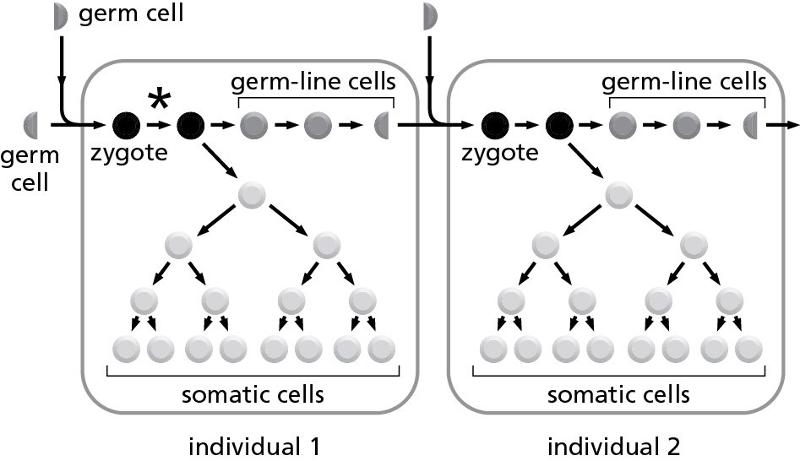
Two individuals are represented in Figure Q9-11; individual 1 is one of the parents of individual 2. The asterisk indicates the occurrence of a single mutation.
What is the chance that individual 2 will inherit the mutation in individual 1?
(a) 100%
(b) 50%
(c) 1 in 100,000
(d) none
(b) 50%
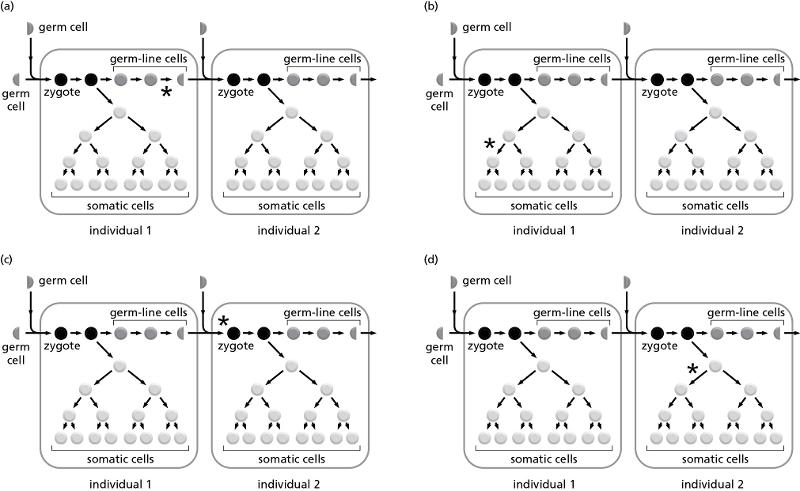
Two individuals are represented in each choice in Figure Q9-10; individual 1 is one of the parents of individual 2. The asterisk seen in each choice indicates the occurrence of a single mutation during the cell division. Which of the choices in Figure Q9-10 will lead to a mutation in every cell of the individual in which the original mutation occurred?
C

Figure Q9-16 shows an experiment used to determine the spontaneous mutation rate in E. coli. If the spontaneous mutation rate in E. coli is 1 mistake in every 109 nucleotides copied, about how many colonies would you expect to see on the plates lacking histidine if you were to assay 1011 cells from the culture for their ability to form colonies?
(a) 1
(b) 2
(c) 10
(d) 100
(d) 100
Which of the following changes is least likely to arise from a point mutation in a regulatory region of a gene?
(a) a mutation that changes the time in an organism’s life during which a protein is expressed
(b) a mutation that eliminates the production of a protein in a specific cell type
(c) a mutation that changes the subcellular localization of a protein
(d) a mutation that increases the level of protein production in a cell
(c) a mutation that changes the subcellular localization of a protein
Which of the following statements about gene families is false?
(a) Because gene duplication can occur when crossover events occur, genes are always duplicated onto homologous chromosomes.
(b) Not all duplicated genes will become functional members of gene families.
(c) Whole-genome duplication can contribute to the formation of gene families.
(d) Duplicated genes can diverge in both their regulatory regions and their coding regions.
(a) Because gene duplication can occur when crossover events occur, genes are always duplicated onto homologous chromosomes.
Which of the following statements about the globin gene family is true?
(a) The globin protein, which can carry oxygen molecules throughout an organism’s body, was first seen in ancient vertebrate species about 500 million years ago.
(b) The gene duplication that led to the expansion of the globin gene family led to the separation and distribution of globin on many chromosomes in mammals, such that no chromosome has more than a single functional member of the globin gene family.
(c) As globin gene family members diverged over the course of evolution, all the DNA sequence variations that have accumulated between family members are within the regulatory DNA sequences that affect when and how strongly each globin gene is expressed.
(d) Some of the duplicated globin genes that arose during vertebrate evolution acquired inactivating mutations and became pseudogenes in modern vertebrates.
(d) Some of the duplicated globin genes that arose during vertebrate evolution acquired inactivating mutations and became pseudogenes in modern vertebrates.
Which of the following statements about pseudogenes is false?
(a) Pseudogenes code for microRNAs.
(b) Pseudogenes share significant nucleotide similarity with functional genes.
(c) Pseudogenes are no longer expressed in the cell.
(d) There are estimated to be approximately 20,000 pseudogenes in the human genome.
(a) Pseudogenes code for microRNAs.
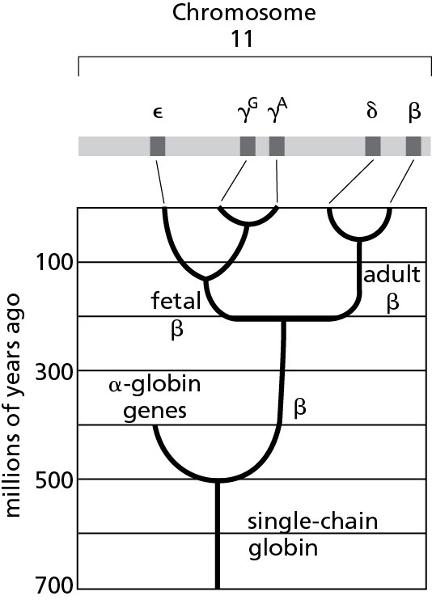
Figure Q9-22 shows the evolutionary history of the globin gene family members.
Given this information, which of the following statements is true?
(a) The ancestral globin gene arose 500 million years ago.
(b) The α-globin gene is more closely related to the ε-globin gene than to the δ-globin gene.
(c) The nucleotide sequences of the two γ-globins will be most similar because they are the closest together on the chromosome.
(d) The fetal β-globins arose from a gene duplication that occurred 200 million years ago, which gave rise to a β-globin expressed in the fetus and a β-globin expressed in the adult.
(d) The fetal β-globins arose from a gene duplication that occurred 200 million years ago, which gave rise to a β-globin expressed in the fetus and a β-globin expressed in the adult.
Which of the following would contribute most to successful exon shuffling?
(a) shorter introns
(b) a haploid genome
(c) exons that code for more than one protein domain
(d) introns that contain regions of similarity to one another
(d) introns that contain regions of similarity to one another
Which of the following statements is true?
(a) The intron structure of most genes is conserved among vertebrates.
(b) The more nucleotides there are in an organism’s genome, the more genes there will be in its genome.
(c) Because the fly Drosophila melanogaster and humans diverged from a common ancestor so long ago, a gene in the fly will show more similarity to another gene from the same species than it will to a human gene.
(d) An organism from the same Order as another will be more likely to have a genome of the same size than will a more evolutionarily diverged animal.
(a) The intron structure of most genes is conserved among vertebrates.
Which of the following statements about homologous genes is true?
(a) For protein-coding genes, homologous genes will show more similarity in their amino acid sequences than in their nucleotide sequences.
(b) Fewer than 1% of human genes have homologs in the nematode and the fruit fly.
(c) Most homologous genes arose by gene duplication.
(d) A gene in humans that has homologs in plants and prokaryotes will show the same level of similarity in nucleotide sequence when the human and prokaryotic sequences are compared as when the human and chimpanzee sequences are compared.
(a) For protein-coding genes, homologous genes will show more similarity in their amino acid sequences than in their nucleotide sequences.
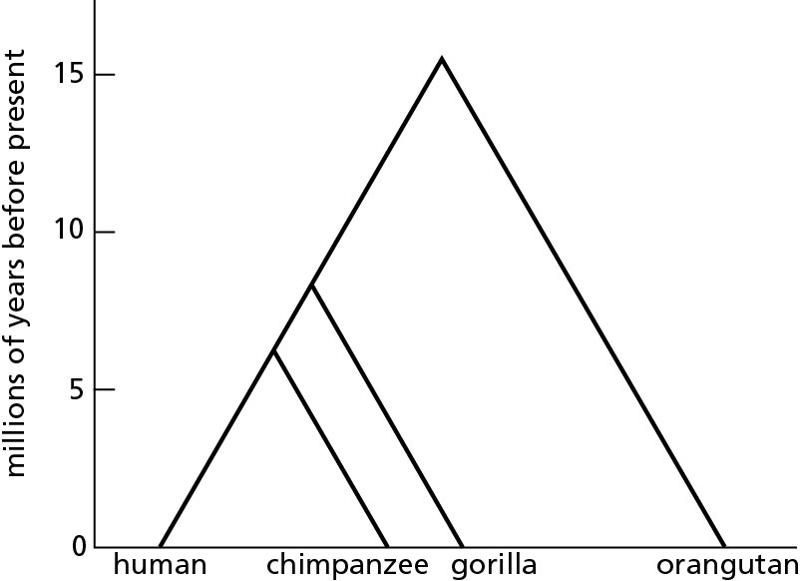
Given the evolutionary relationship between higher primates shown in Figure Q9-28, which of the following statements is false?
(a) The last common ancestor of humans, chimpanzees, gorillas, and orangutans lived about 14 million years ago.
(b) Chimpanzees are more closely related to gorillas than to humans.
(c) Humans and chimpanzees diverged about 6 million years ago.
(d) Orangutans are the most divergent of the four species shown in Figure Q9-28.
(b) Chimpanzees are more closely related to gorillas than to humans.
Which of the following statements is false?
(a) The human genome is more similar to the orangutan genome than it is to the mouse genome.
(b) A comparison of genomes shows that 90% of the human genome shares regions of conserved synteny with the mouse genome.
(c) Primates, dogs, mice, and chickens all have about the same number of genes.
(d) Genes that code for ribosomal RNA share significant similarity in all eukaryotes but are much more difficult to recognize in archaea.
(d) Genes that code for ribosomal RNA share significant similarity in all eukaryotes but are much more difficult to recognize in archaea.
The pufferfish, Fugu rubripes, has a genome that is one-tenth the size of mammalian genomes. Which of the following statements is not a possible reason for this size difference?
(a) Intron sequences in Fugu are shorter than those in mammals.
(b) Fugu lacks the repetitive DNA found in mammals.
(c) The Fugu genome seems to have lost sequences faster than it has gained sequences over evolutionary time.
(d) Fugu has lost many genes that are part of gene families.
(d) Fugu has lost many genes that are part of gene families.
Which of the following regions of the genome is the least likely to be conserved over evolutionary time?
(a) the upstream regulatory region of a gene that encodes the region conferring tissue specificity
(b) the upstream regulatory region of a gene that binds to RNA polymerase
(c) the portion of the genome that codes for proteins
(d) the portion of the genome that codes for RNAs that are not translated into protein
(a) the upstream regulatory region of a gene that encodes the region conferring tissue specificity
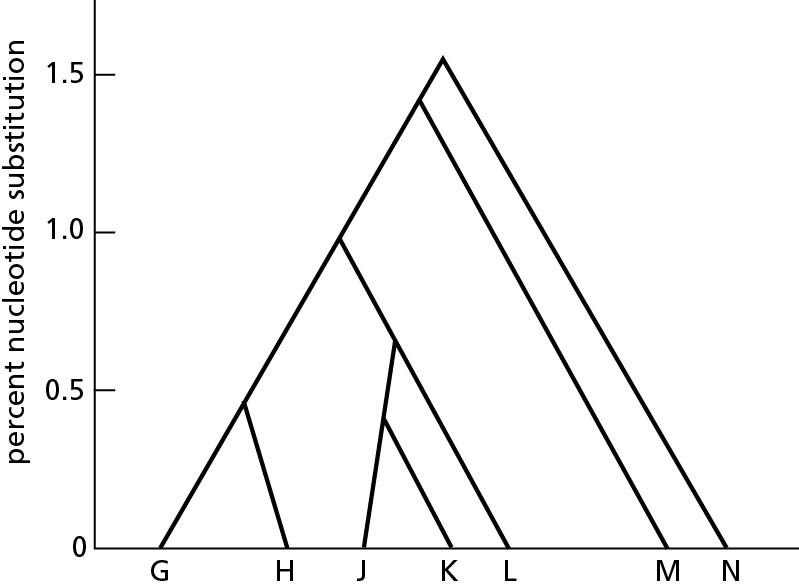
The evolutionary relationships between seven different species—G, H, J, K, L, M, and N—are diagrammed in Figure Q9-33.
Given this information, which of the following statements is false?
(a) These are all highly related species, because the sequence divergence between the most divergent species is 3%.
(b) Species M is just as related to species G as it is to species J.
(c) Species N is more closely related to the last common ancestor of all of these species than to any of the other species shown in the diagram.
(d) Species G and H are as closely related to each other as species J and K are to each other.
(c) Species N is more closely related to the last common ancestor of all of these species than to any of the other species shown in the diagram.
All highly conserved stretches of DNA in the genome are transcribed into RNA.
true or false
False. Many highly conserved stretches of DNA are not transcribed but instead contain information critical for regulating where and when genes are expressed.
To find functionally important regions of the genome, it is more useful to compare species whose last common ancestor lived 100 million years ago rather than 5 million years ago.
true or false
True. Species that diverged recently have many identical stretches of DNA sequence by chance, whereas sequence similarity between species that diverged long ago is probably due to functional constraints. The sequences that are necessary to preserve the function of the gene will not be able to undergo changes and thus are more likely to be similar between species that diverged long ago.
Most mutations and genome alterations have neutral consequences.
true or false
True. Most genomic changes do not alter the amino acid sequence of proteins or the regulatory properties of genes. Even some mutations that cause minor alterations have little effect on protein function.
Proteins required for growth, metabolism, and cell division are more highly conserved than those involved in development and in response to the environment.
true or false
True. All organisms need to perform a similar basic set of fundamental functions, such as those for metabolism, protein synthesis, and DNA replication. Proteins involved in these functions are shared by descent, and their evolution is constrained. Different species and cells are likely to require different developmental paths and to encounter different environmental challenges, so the proteins involved in these processes will tend to be more variable. For example, bacteria do not undergo elaborate developmental programs and so lack many of the regulators of development found in eukaryotes.
Introns and transposons tend to slow the evolution of new genes.
true or false
False. Introns and transposons can act as sites where recombinational crossovers occur. Transposons can also catalyze genetic rearrangements. Rearrangements occurring within these sequences are less likely to be detrimental than those occurring elsewhere in the genome. In general, only the short intron sequences required for splicing are important to intron function; alterations in sequences outside the splicing sites may have no consequences for intron function and thus will not be subject to purifying selection.
Which of the following functions do you not expect to find in the set of genes found in all organisms on Earth?
(a) DNA replication
(b) DNA repair
(c) protein production
(d) RNA splicing
(d) RNA splicing
Which of the following generalities about genomes is true?
(a) All vertebrate genomes contain roughly the same number of genes.
(b) All unicellular organisms contain roughly the same number of genes.
(c) The larger an organism, the more genes it has.
(d) The more types of cell an organism has, the more genes it has.
(a) All vertebrate genomes contain roughly the same number of genes.
Which of the following statements about mobile genetic elements is true?
(a) Mobile genetic elements can sometimes rearrange the DNA sequences of the genome in which they are embedded by accidentally excising neighboring chromosomal regions and reinserting these sequences into different places within the genome.
(b) DNA-only transposons do not code for proteins but instead rely on transposases found in cells that are infected by viruses.
(c) The two major families of transposable sequences found in the human genome are DNA-only transposons that move by replicative transposition.
(d) During cut-and-paste transposition, the donor DNA will no longer have the mobile genetic element embedded in its sequence when transposition is complete.
(d) During cut-and-paste transposition, the donor DNA will no longer have the mobile genetic element embedded in its sequence when transposition is complete.
Mobile genetic elements are sometimes called “jumping genes,” because they move from place to place throughout the genome. The exact mechanism by which they achieve this mobility depends on the genes contained within the mobile element. Which of the following mobile genetic elements carries both a transposase gene and a reverse transcriptase gene?
(a) L1
(b) B1
(c) Alu
(d) Tn3
(a) L1
Which of the following is true of a retrovirus but not of the Alu retrotransposon?
(a) It requires cellular enzymes to make copies.
(b) It can be inserted into the genome.
(c) It can be excised and moved to a new location in the genome.
(d) It encodes its own reverse transcriptase.
(d) It encodes its own reverse transcriptase.
Which of the following DNA sequences is not commonly carried on a DNA-only transposon?
(a) transposase gene
(b) reverse transcriptase gene
(c) recognition site for transposase
(d) antibiotic-resistance gene
(b) reverse transcriptase gene
HIV is a human retrovirus that integrates into the host cell’s genome and will eventually replicate, produce viral proteins, and ultimately escape from the host cell. Which of the following proteins is not encoded in the HIV genome?
(a) reverse transcriptase
(b) envelope protein
(c) RNA polymerase
(d) capsid protein
(c) RNA polymerase
In humans and in chimpanzees, 99% of the Alu retrotransposons are in corresponding positions. Which of the following statements below is the most likely explanation for this similarity?
(a) The Alu retrotransposon is not capable of transposition in humans.
(b) Most of the Alu sequences in the chimpanzee genome underwent duplication and divergence before humans and chimpanzees diverged.
(c) The Alu retrotransposons are in the most beneficial position in the genome for primates.
(d) The Alu retrotransposons must also be in the same position in flies.
(b) Most of the Alu sequences in the chimpanzee genome underwent duplication and divergence before humans and chimpanzees diverged.
Viral genomes _________.
(a) can be made of DNA.
(b) can be made of RNA.
(c) can be either double-stranded or single-stranded.
(d) All answers above are true.
(d) All answers above are true.
Which of the following statements about retroviruses is false?
(a) Retroviruses are packaged with a few molecules of reverse transcriptase in each virus particle.
(b) Retroviruses use the host-genome integrase enzyme to create the provirus.
(c) The production of viral RNAs can occur long after the initial infection of the host cell by the retrovirus.
(d) Viral RNAs are translated by host-cell ribosomes to produce the proteins required for the production of viral particles.
(b) Retroviruses use the host-genome integrase enzyme to create the provirus.
A finished draft of the human genome was published in ______.
(a) 1965.
(b) 1984.
(c) 2004.
(d) 2012.
(c) 2004.
Which of the following statements about the human genome is false?
(a) About 50% of the human genome is made up of mobile genetic elements.
(b) More of the human genome comprises intron sequences than exon sequences.
(c) About 1.5% of the human genome codes for exons.
(d) Only the exons are conserved between the genomes of humans and other mammals.
(d) Only the exons are conserved between the genomes of humans and other mammals.
The nucleotide sequences between individuals differ by 0.1%, yet the human genome is made up of about 3 × 109 nucleotide pairs. Which of the following statements is false?
(a) In most human cells, the homologous autosomes differ from each other by 0.1%.
(b) All changes between human individuals are single-nucleotide polymorphisms.
(c) Any two individuals (other than identical twins) will generally have more than 3 million genetic differences in their genomes.
(d) Much of the variation between human individuals was present 100,000 years ago, when the human population was small.
(b) All changes between human individuals are single-nucleotide polymorphisms.
Which of the following processes is not thought to contribute to diversity in the genome of human individuals?
(a) exon shuffling
(b) single-nucleotide polymorphisms
(c) CA repeats
(d) duplication and deletion of large blocks of sequence
(a) exon shuffling
The increased complexity of humans compared with flies and worms is largely due to the vastly larger number of genes in humans.
true or false
False. The number of genes differs only by about a factor of two. It is thought that the increased complexity of humans is due largely to differences in when and where the genes are expressed. Differences in the timing of splicing may also be a major contributor to the relative complexity of humans.
Repeats of the CA dinucleotide are useful for crime investigations and other forensic applications.
true or false
True. There are CA repeats in many locations throughout the genome. Because the number of repeats at a given location varies greatly between individuals and families, it can be used as an identifying characteristic to match two samples (such as blood samples) from the same or related individuals.
Most single-nucleotide polymorphisms cause no observable functional differences between individual humans.
true or false
True. Nearly all single-nucleotide polymorphisms have no effect on the appearance or behavior of the individual, but a few cause important differences.
There is little conserved synteny between human and mouse genes.
true or false
False. Human and mouse chromosomes show extensive synteny, with blocks of chromosomal DNA exhibiting homologous genes arranged in the same order between the two species.
The differences between multicellular organisms are largely explained by the different kinds of genes carried on their chromosomes.
true or false
False. Multicellular organisms are built from essentially the same toolbox of gene building blocks, but the parts are put together differently because of regulatory differences that dictate when and where and how much of each protein is made. Alternative splicing can also have an important role, as it can generate several proteins from a single gene in some species, yet the homologous gene in other species may produce only one protein.
The number of distinct protein species found in humans and other organisms can vastly exceed the number of genes. This is largely due to ______________.
(a) protein degradation.
(b) alternative splicing.
(c) homologous genes.
(d) mutation.
(b) alternative splicing.
You are studying a gene that has four exons and can undergo alternative splicing. Exon 1 has two alternatives, exon 2 has five alternatives, exon 3 has three alternatives, and exon 4 has four alternatives. If all possible splicing combinations were used, how many different splice isoforms could be produced for this gene?
(a) 22
(b) 30
(c) 60
(d) 120
(d) 2 × 5 × 3 × 4 = 120.
Alternative exons can arise through the duplication and divergence of existing exons. What type of mutation below would be least tolerated during the evolution of a new exon?
(a) a nucleotide change of A to G
(b) a deletion of three consecutive bases
(c) mutation of the first nucleotide in the intron
(d) a nucleotide change that alters a TT dinucleotide to AA
(c) mutation of the first nucleotide in the intron
Which of the following statements about what we have learned by comparing the modern-day human genome to other genomes is true?
(a) Modern humans whose ancestors come from Europe or Asia share up to 4 percent of their genome with Neanderthals.
(b) Accelerated changes, which were found when comparing the human genome to other mammalian genomes, were not found when comparing the modern-day human genome to the Neanderthal genome.
(c) The human genome is far more gene-dense than the yeast genome.
(d) In syntenic regions of the human and mouse genomes, both gene order and the placements of more than 95% of the mobile genetic elements are conserved.
(a) Modern humans whose ancestors come from Europe or Asia share up to 4 percent of their genome with Neanderthals.
The yeast genome was sequenced more than 15 years ago, yet the total number of genes continues to be refined. The sequencing of closely related yeast species was important for validating the identity of short (less than 100 nucleotides long) open reading frames (ORFs) that were otherwise difficult to predict. What is the main reason that these short ORFs are hard to find without the genomes of other yeast for comparison?
(a) Short ORFs are found only in yeast.
(b) The short ORFs code for RNAs.
(c) Many short stretches of DNA may lack a stop codon simply by chance, making it difficult to distinguish those DNA sequences that code for proteins from those that do not.
(d) Short ORFs occur mainly in gene-rich regions, making them difficult to identify by computer programs
(c) Many short stretches of DNA may lack a stop codon simply by chance, making it difficult to distinguish those DNA sequences that code for proteins from those that do not.
Recombinant DNA technologies involve techniques that permit the creation of custom-made DNA molecules that can be introduced back into living organisms. These technologies were first developed in the ______.
(a) 1930s.
(b) 1950s.
(c) 1970s.
(d) 1990s.
(c) 1970s.
Which of the following statements about restriction nucleases is false?
(a) A reproducible set of DNA fragments will be produced every time a restriction nuclease digests a known piece of DNA.
(b) Restriction nucleases recognize specific sequences on single-stranded DNA.
(c) Some bacteria use restriction nucleases as protection from foreign DNA.
(d) Some restriction nucleases cut in a staggered fashion, leaving short, single-stranded regions of DNA at the ends of the cut molecule.
(b) Restriction nucleases recognize specific sequences on single-stranded DNA.
You have purified DNA from your recently deceased goldfish. Which of the following restriction nucleases would you use if you wanted to end up with DNA fragments with an average size of 70 kilobase pairs (kb) after complete digestion of the DNA? The recognition sequence for each enzyme is indicated in the right-hand column.
(a) Sau3AI GATC
(b) BamHI GGATCC
(c) NotI GCGGCCGC
(d) XzaI GAAGGATCCTTC
(c) NotI GCGGCCGC
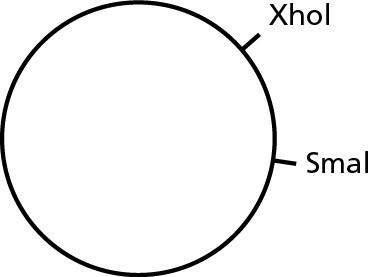
You have a piece of circular DNA that can be cut by the restriction nucleases XhoI and SmaI, as indicated in Figure Q10-5.
If you were to cut this circular piece of DNA with both XhoI and SmaI, how many fragments of DNA would you end up with?
(a) 1
(b) 2
(c) 3
(d) 4
(b) 2
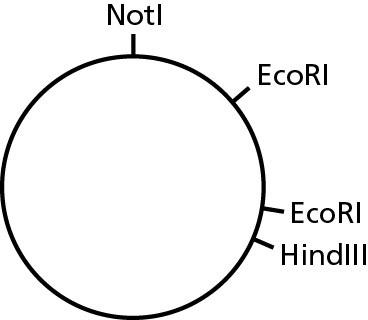
You have a piece of circular DNA that can be cut by the restriction nucleases EcoRI, HindIII, and NotI, as indicated in Figure Q10-6.
Which of the following statements is false?
(a) One piece of DNA will be obtained when this DNA is cut by NotI.
(b) A piece of DNA that cannot be cut by EcoRI will be obtained by cutting this DNA with both NotI and HindIII.
(c) Two DNA fragments that cannot be cut by HindIII will be obtained when this DNA is cut by EcoRI and NotI.
(d) Two DNA fragments of unequal size will be created when this DNA is cut by both HindIII and EcoRI.
(d) Two DNA fragments of unequal size will be created when this DNA is cut by both HindIII and EcoRI.
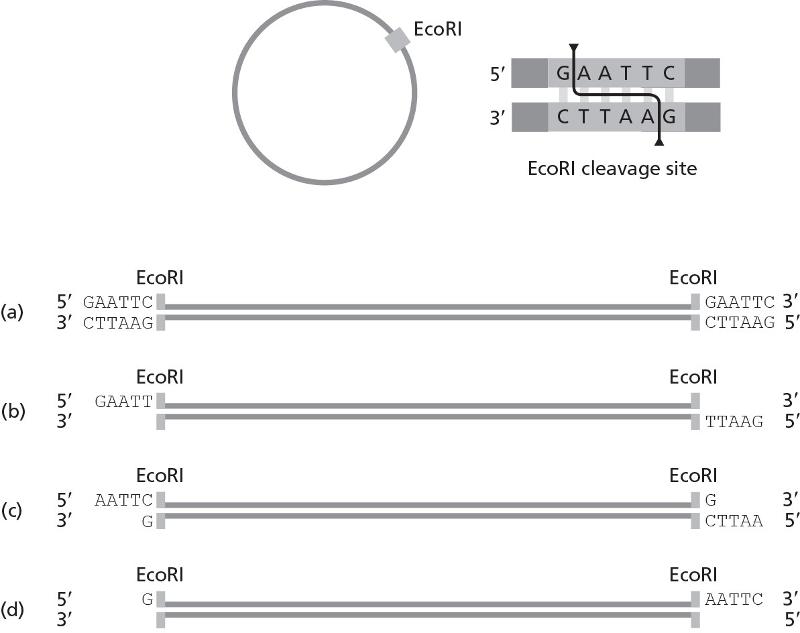
You have a circular plasmid that has a single EcoRI site in it, as diagrammed in Figure Q10-7, which also shows the cleavage site for EcoRI. Choose the answer below that best represents what the end of the DNA molecule will look like once you cut the plasmid with EcoRI. Note that only the very ends of the DNA molecule are shown in the answers
C
During gel electrophoresis, DNA fragments _______________________.
(a) travel through a matrix containing a microscopic network of pores.
(b) migrate toward a negatively charged electrode.
(c) can be visualized without stains or labels.
(d) are separated on the basis of their sequence.
(a) travel through a matrix containing a microscopic network of pores.
A double-stranded DNA molecule can be separated into single strands by heating it to 90°C because _______________________.
(a) heat disrupts the hydrogen bonds holding the sugar–phosphate backbone together.
(b) DNA is negatively charged.
(c) heat disrupts hydrogen-bonding between complementary nucleotides.
(d) DNA is positively charged.
(c) heat disrupts hydrogen-bonding between complementary nucleotides.
You are interested in a single-stranded DNA molecule that contains the following sequence:
5′- .....GATTGCAT.... -3′
Which molecule can be used as a probe that will hybridize to your sequence of interest?
(a) 5′-GATTGCAT-3′
(b) 5′-TACGTTAG-3′
(c) 5′-CTAACGTA-3′
(d) 5′-ATGCAATC-3′
(d) 5′-ATGCAATC-3′
During DNA renaturation, two DNA strands will ________.
(a) break the covalent bonds that hold the nucleotides together while maintaining the hydrogen bonds that hold the two strands together.
(b) break the hydrogen bonds that hold the two strands together with no effect on the covalent bonds that hold the nucleotides together.
(c) re-form a double helix if the two strands have complementary sequences.
(d) re-form a double helix if the two strands are identical in sequence.
(c) re-form a double helix if the two strands have complementary sequences.
Which of the following statements about gel-transfer hybridization (or Southern blotting) is false?
(a) This technique involves the transfer of DNA molecules from gel onto nitrocellulose paper or nylon paper.
(b) In this technique, single-stranded DNA is separated by electrophoresis.
(c) A labeled DNA probe binds to the DNA by hybridization.
(d) The DNA that is separated on a gel is not labeled.
(b) In this technique, single-stranded DNA is separated by electrophoresis.
DNA ligase is an enzyme used when making recombinant DNA molecules in the lab. In what normal cellular process is DNA ligase involved?
(a) none, it is only found in virally infected cells
(b) transcription
(c) transformation
(d) DNA replication
(d) DNA replication
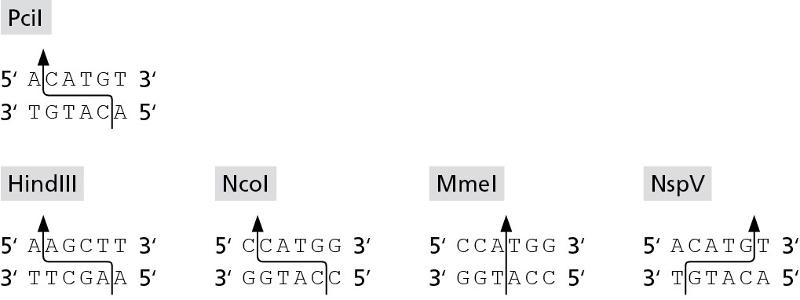
Figure Q10-19 shows the cleavage sites of several restriction nucleases
You cut a vector using the PciI restriction nuclease. Which of the following restriction nucleases will generate a fragment that can be ligated into this cut vector with the addition of only ligase and ATP?
(a) HindIII
(b) NcoI
(c) MmeI
(d) NspV
(b) NcoI

Figure Q10-20 depicts a strategy by which a DNA fragment produced by cutting with the EcoRI restriction nuclease can be joined to a DNA fragment produced by cutting DNA with the HaeIII restriction nuclease.
Note that cutting DNA with EcoRI produces a staggered end, whereas cutting DNA with HaeIII produces a blunt end. Why must polymerase be added in this reaction?
(a) Polymerase will fill in the staggered end to create a blunt end.
(b) Polymerase is needed to seal nicks in the DNA backbone.
(c) Polymerase will add nucleotides to the end produced by the HaeIII restriction nuclease.
(d) Without polymerase, there will not be enough energy for the reaction to proceed.
(a) Polymerase will fill in the staggered end to create a blunt end.
DNA can be introduced into bacteria by a mechanism called ____________.
(a) transcription.
(b) ligation.
(c) replication.
(d) transformation.
(d) transformation.
A plasmid ______________.
(a) can confer antibiotic resistance to a bacterium.
(b) is a single-stranded circular DNA molecule that can undergo horizontal transfer among bacteria.
(c) is a tool designed in the lab and never found in naturally occurring bacteria.
(d) always becomes part of the bacterial chromosome during transformation.
(a) can confer antibiotic resistance to a bacterium.
Which of the following statements about DNA libraries is true?
(a) Production of a DNA library involves the direct insertion of short DNA fragments into bacteria through transformation.
(b) By placing the library DNA into bacteria, the bacteria can be used to amplify the desired DNA fragments from the DNA library.
(c) Individual bacteria that have taken up most of the library DNA are selected for during the construction of a DNA library.
(d) The library DNA within the bacteria will only be replicated when it hybridizes to a DNA probe.
(b) By placing the library DNA into bacteria, the bacteria can be used to amplify the desired DNA fragments from the DNA library.
Which of the following statements about genomic DNA libraries is false?
(a) The larger the size of the fragments used to make the library, the fewer colonies you will have to examine to find a clone that hybridizes to your probe.
(b) The larger the size of the fragments used to make the library, the more difficult it will be to find your gene of interest once you have identified a clone that hybridizes to your probe.
(c) The larger the genome of the organism from which a library is derived, the larger the fragments inserted into the vector will tend to be.
(d) The smaller the gene you are seeking, the more likely it is that the gene will be found on a single clone.
(c) The larger the genome of the organism from which a library is derived, the larger the fragments inserted into the vector will tend to be.
A DNA library has been constructed by purifying chromosomal DNA from mice, cutting the DNA with the restriction enzyme NotI, and inserting the fragments into the NotI site of a plasmid vector. What information cannot be retrieved from this library?
(a) gene regulatory sequences
(b) intron sequences
(c) sequences of the telomeres (the ends of the chromosomes)
(d) amino acid sequences of proteins
(c) sequences of the telomeres (the ends of the chromosomes)
You want to design a DNA probe used for hybridization to isolate a clone from a cDNA library. Which of the following concerns about DNA probe design is the most legitimate?
(a) You must be careful when designing your probe to take into account which DNA strand was transcribed in mRNA and choose a probe complementary to the mRNA.
(b) You must be careful not to include any DNA sequences in your probe that are upstream (5′) of the AUG start codon.
(c) You must make sure that all the DNA sequences in your probe lie within an exon, and do not span two exons.
(d) You must make sure that all the DNA sequences in your probe are not located downstream (3′) of the polyadenylation signal.
(d) You must make sure that all the DNA sequences in your probe are not located downstream (3′) of the polyadenylation signal.
You want to design a DNA probe used for hybridization to isolate a clone from a cDNA library. Which of the following statements about DNA probes is true?
(a) The shorter the DNA probe used to probe the library, the greater the number of colonies to which the probe might hybridize.
(b) A DNA probe that contains sequences that span two exons is better suited to the purpose than a DNA probe that only contains sequences from one exon.
(c) A DNA probe that contains sequences immediately upstream of the DNA that codes for the first methionine in the open reading frame will usually not hybridize to clones in a cDNA library.
(d) Hybridization of a DNA probe to the plasmid of interest will permit the detection of the clone of interest; labeling of the DNA probe is not necessary.
(a) The shorter the DNA probe used to probe the library, the greater the number of colonies to which the probe might hybridize.
PCR was invented in _______.
(a) the 1800s.
(b) the 1950s.
(c) the 1980s.
(d) 2009.
(c) the 1980s.
Starting with one double-stranded DNA molecule, how many cycles of PCR would you have to perform to produce about 100 double-stranded copies (assuming 100% efficiency per cycle)?
(a) 2
(b) 7
(c) 25
(d) 100
(b) 7
Which of the following statements about PCR is false?
(a) PCR uses a DNA polymerase from a thermophilic bacterium.
(b) PCR is particularly powerful because after each cycle of replication, there is a linear increase in the amount of DNA available.
(c) For PCR, every round of replication is preceded by the denaturation of the double-stranded DNA molecules.
(d) The PCR will generate a pool of double-stranded DNA molecules, most of which will have DNA from primers at the 5′ ends.
(b) PCR is particularly powerful because after each cycle of replication, there is a linear increase in the amount of DNA available.
PCR involves a heating step, followed by a cooling step, and then DNA synthesis. What is the primary reason for why this cooling step is necessary?
(a) Cooling the reaction ensures the integrity of the covalent bonds holding the nucleotides together in the DNA strand.
(b) Cooling the reaction gives the DNA polymerase an opportunity to rest from the previous cycle so that it will be ready for the next round of synthesis.
(c) Transcription takes place during the cooling step.
(d) Cooling the reaction brings the temperature down to a level that is compatible with the short primers forming stable hydrogen bonds with the DNA to be amplified.
(d) Cooling the reaction brings the temperature down to a level that is compatible with the short primers forming stable hydrogen bonds with the DNA to be amplified.
Which of the following limits the use of PCR to detect and isolate genes?
(a) The sequence at the beginning and end of the DNA to be amplified must be known.
(b) It also produces large numbers of copies of sequences beyond the 5′ or 3′ end of the desired sequence.
(c) It cannot be used to amplify cDNAs or mRNAs.
(d) It will amplify only sequences present in multiple copies in the DNA sample.
(a) The sequence at the beginning and end of the DNA to be amplified must be known.
Why is an excess of normal deoxyribonucleoside triphosphate molecules (dNTPs) needed during dideoxy sequencing?
(a) DNA polymerase uses the dNTPs to synthesize a DNA molecule complementary to the molecule being sequenced.
(b) dNTPs are consumed as energy to fuel the sequencing reactions.
(c) When dNTP levels are too low, there will be very few chain-termination events.
(d) The dNTPs can hybridize to the fragment to be sequenced and serve as primers for DNA polymerase.
(a) DNA polymerase uses the dNTPs to synthesize a DNA molecule complementary to the molecule being sequenced.
Why are dideoxyribonucleoside triphosphates used during DNA sequencing?
(a) They cannot be incorporated into DNA by DNA polymerase.
(b) They are incorporated into DNA particularly well by DNA polymerases from thermophilic bacteria.
(c) Incorporation of a dideoxyribonucleoside triphosphate leads to the termination of replication for that strand.
(d) Dideoxyribonucleoside triphosphates are more stable than deoxyribonucleoside triphosphates.
(c) Incorporation of a dideoxyribonucleoside triphosphate leads to the termination of replication for that strand.
With fully automated Sanger sequencing, all four chain-terminating ddNTPs can be added into a single reaction. This is different from the traditional slab gel Sanger sequencing, where a different reaction had to be carried out for each ddNTP. The mixing of all four ddNTPs can be carried out because ______________.
(a) the fully automated Sanger sequencing reactions are loaded onto a capillary gel.
(b) the fully automated Sanger sequencing reactions utilize ddNTPs each labeled with a different fluorescent tag, which allows all four ddNTPs to be incorporated into a single molecule of DNA.
(c) the fully automated Sanger sequencing reactions generate a set of products, each of which carries a single fluorescent tag whose color reveals the identity of the base that is at the end of the product.
(d) the fully automated Sanger sequencing reactions do not require DNA polymerase because the bases are read as the DNA is pulled through a tiny pore at the end of the capillary gel.
(c) the fully automated Sanger sequencing reactions generate a set of products, each of which carries a single fluorescent tag whose color reveals the identity of the base that is at the end of the product.
Second-generation sequencing differs from Sanger sequencing because _____________.
(a) second-generation sequencing does not depend on chain-terminator ddNTPs.
(b) second-generation sequencing does not require DNA polymerase.
(c) for the cost per base sequenced, second-generation sequencing is much more expensive than Sanger sequencing.
(d) second-generation sequencing can sequence tens of millions of pieces of DNA at the same time on a single glass slide.
(d) second-generation sequencing can sequence tens of millions of pieces of DNA at the same time on a single glass slide.
Which of the following techniques is not appropriate if you want to examine the transcriptome of a specific tissue?
(a) in situ hybridization
(b) production of a cDNA library
(c) RNA-Seq
(d) microarray analysis
(a) in situ hybridization
You create a recombinant DNA molecule that fuses the coding sequence of green fluorescent protein to the regulatory DNA sequences that control the expression of your favorite genes. Which of the following pieces of information can you NOT gain by examining the expression of this reporter gene?
(a) the tissue where the protein encoded by this gene is expressed
(b) the cell in which the protein encoded by this gene is expressed
(c) the specific location within the cell of the protein encoded by this gene
(d) when, during an organism’s development, this gene is expressed
(c) the specific location within the cell of the protein encoded by this gene
Which of the following statements about RNA interference (or RNAi) is false?
(a) RNAi is a natural mechanism used to regulate genes.
(b) During the process of RNAi, hybridization of a small RNA molecule with the mRNA degrades the mRNA.
(c) Because RNAi depends on the introduction of a double-stranded RNA into a cell or an organism, it is not a process that can cause heritable changes in gene expression.
(d) In C. elegans, RNAi can be introduced into the animals by feeding them with bacteria that produce the inhibitory RNA molecules.
(c) Because RNAi depends on the introduction of a double-stranded RNA into a cell or an organism, it is not a process that can cause heritable changes in gene expression.
You have been hired to create a cat that will not cause allergic reactions in cat-lovers. Your coworkers have cloned the gene encoding a protein found in cat saliva, expressed the protein in bacteria, and shown that it causes violent allergic reactions in people. But you soon realize that even if you succeed in making a knockout cat lacking this gene, anyone who buys one will easily be able to make more hypoallergenic cats just by breeding them. Which of the following will ensure that people will always have to buy their hypoallergenic cats from you?
(a) Inject the modified embryonic stem (ES) cells into embryos that have a genetic defect to prevent the mature adult from reproducing.
(b) Implant the injected embryos into a female cat that is sterile as a result of a genetic defect.
(c) Sell only the offspring from the first litter of the female cat implanted with the injected embryos.
(d) Surgically remove the sexual organs of all the knockouts before you sell them.
(d) Surgically remove the sexual organs of all the knockouts before you sell them.
Insulin is a small protein that regulates blood sugar level and is given to patients who suffer from diabetes. Many years ago, diabetics were given insulin that had been purified from pig pancreas. Once recombinant DNA techniques became available, the DNA encoding insulin could be placed into an expression vector and insulin could be produced in bacteria. Which of the following is NOT a reason why purifying insulin from bacteria is a better way to produce insulin for diabetics than using insulin purified from a pig pancreas.
(a) Insulin can be easily produced in large quantities from cells carrying the cloned DNA sequence.
(b) The creation of transgenic pigs that expressed insulin was very expensive compared to the cost of creating bacteria that expressed insulin.
(c) Insulin made from a bacterial culture and then purified will be free of any possible contaminating viruses that pigs (and any other animals) harbor. Since pigs are more closely related to people than bacteria are, their viruses are more likely to be harmful to people than are viruses that might infect bacteria.
(d) The pig protein has slight amino acid differences compared to the human protein, so human insulin produced by bacteria will work better in people.
(b) The creation of transgenic pigs that expressed insulin was very expensive compared to the cost of creating bacteria that expressed insulin.
Which of the following describes a feature found in bacterial expression vectors but not in cloning vectors?
(a) origin of replication
(b) cleavage sites for restriction nucleases
(c) promoter DNA sequences
(d) a polyadenylation signal
(c) promoter DNA sequences
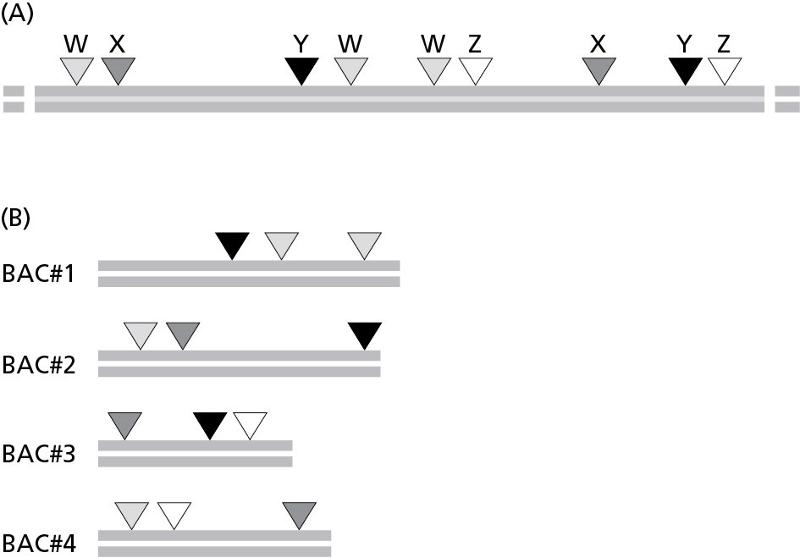
Figure Q10-64A depicts the restriction map of one segment of the human genome for four restriction nucleases W, X, Y, and Z. Figure Q10-64B depicts the restriction maps of four individual BAC clones that contain segments of human DNA from the region depicted in Figure Q10-64A.
From this information, how would you order these BAC clones, from left to right?
(a) 1, 2, 3, 4
(b) 2, 1, 4, 3
(c) 3, 4, 2, 1
(d) 4, 1, 3, 2
(b) 2, 1, 4, 3
Which of the following phenomena will be observed if a cell’s membrane is pierced?
(a) the membrane reseals
(b) the membrane collapses
(c) a tear is formed
(d) the membrane expands
(a) the membrane reseals
The plasma membrane serves many functions, many of which depend on the presence of specialized membrane proteins. Which of the following roles of the plasma membrane could still occur if the bilayer were lacking these proteins?
(a) intercellular communication
(b) selective permeability
(c) cellular movement
(d) import/export of molecules
(b) selective permeability
Which type of lipids are the most abundant in the plasma membrane?
(a) phospholipids
(b) glycolipids
(c) sterols
(d) triacylglycerides
(a) phospholipids
Although cholesterol is a hydrophobic molecule, it has a hydrophilic head group like all other membrane lipids.
true or false
true
Phosphatidylserine is the most abundant type of phospholipid found in cell membranes.
true or false
False. Phosphatidylcholine is the most abundant phospholipid found in cell membranes.
Glycolipids lack the glycerol component found in phospholipids.
true or false
true
The highly ordered structure of the lipid bilayer makes its generation and maintenance energetically unfavorable.
true or false
False. The formation of a lipid bilayer is energetically favorable.
Which of the following membrane lipids does not contain a fatty acid tail?
(a) phosphatidylcholine
(b) a glycolipid
(c) phosphatidylserine
(d) cholesterol
(d) cholesterol
Formation of a lipid bilayer is energetically favorable. How does this arrangement result in higher entropy for the system, and thus make bilayer formation energetically favorable?
(a) Polar head groups form a hydrogen-bonding network at the interface with water.
(b) Water molecules form cagelike structures around hydrophobic molecules.
(c) Hydrogen bonds form between neighboring polar head groups in the bilayer.
(d) Fatty acid tails are highly saturated and flexible.
(b) Water molecules form cagelike structures around hydrophobic molecules.
Which of the following statements is true?
(a) Phospholipids will spontaneously form liposomes in nonpolar solvents.
(b) In eukaryotes, all membrane-enclosed organelles are surrounded by one lipid bilayer.
(c) Membrane lipids diffuse within the plane of the membrane.
(d) Membrane lipids frequently flip-flop between one monolayer and the other.
(c) Membrane lipids diffuse within the plane of the membrane.
A bacterium is suddenly expelled from a warm human intestine into the cold world outside. Which of the following adjustments might the bacterium make to maintain the same level of membrane fluidity?
(a) Produce lipids with hydrocarbon tails that are longer and have fewer double bonds.
(b) Produce lipids with hydrocarbon tails that are shorter and have more double bonds.
(c) Decrease the amount of cholesterol in the membrane.
(d) Decrease the amount of glycolipids in the membrane.
(b) Produce lipids with hydrocarbon tails that are shorter and have more double bonds.
Some lipases are able to cleave the covalent bonds between the glycerol backbone and the attached fatty acid. What final products do you expect to accumulate through the action of the enzyme monoacylglycerol lipase?
(a) phosphoglycerol and free fatty acid
(b) sterol and glycerol
(c) free phosphate and glycerol
(d) glycerol and free fatty acid
(d) glycerol and free fatty acid
Which of the following phospholipid precursors is the most hydrophobic?
(a) triacylglycerol
(b) diacylglycerol
(c) phosphate
(d) glycerol
(a) triacylglycerol
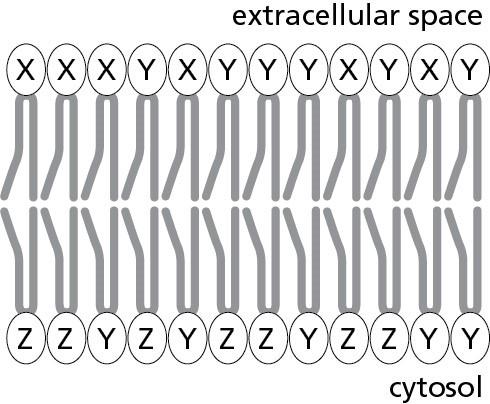
Three phospholipids X, Y, and Z are distributed in the plasma membrane as indicated in Figure Q11-14. For which of these phospholipids does a flippase probably exist?
(a) X only
(b) Z only
(c) X and Y
(d) Y and Z
(c) X and Y
Where does most new membrane synthesis take place in a eukaryotic cell?
(a) in the Golgi apparatus
(b) in the endoplasmic reticulum
(c) in the plasma membrane
(d) in the mitochondria
(e) on ribosomes
(b) in the endoplasmic reticulum
Water molecules readily form hydrogen bonds with other polar molecules, and when they encounter nonpolar molecules they must form hydrogen-bonding networks with neighboring water molecules. Which of the following molecules will cause a “cage” of water to form?
(a) 2-methylpropane
(b) acetone
(c) methanol
(d) urea
(a) 2-methylpropane
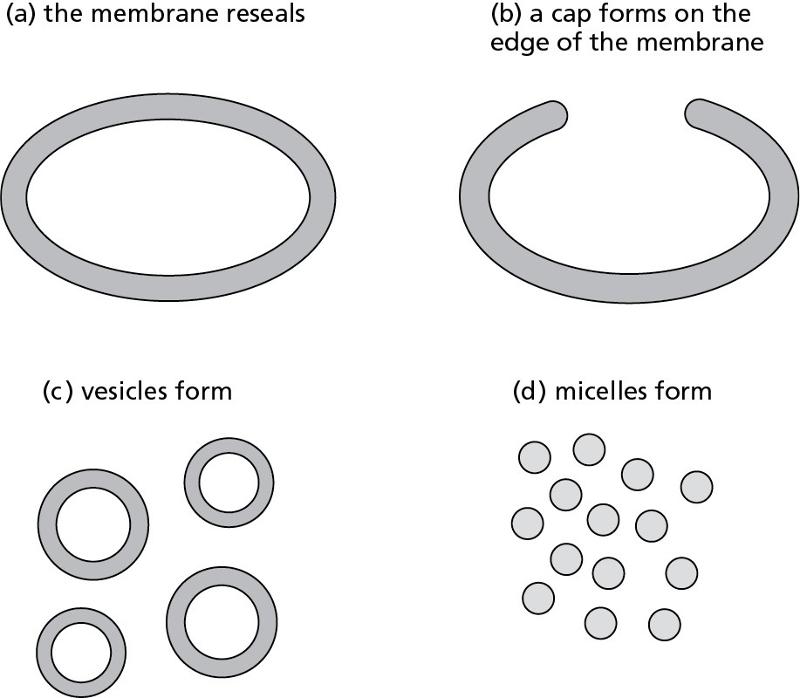
Membranes undergo spontaneous rearrangement if torn. Which of the following would happen if a cell membrane had a large tear?
C
Membrane lipids are capable of many different types of movement. Which of these does not occur spontaneously in biological membranes?
(a) switching between lipid layers
(b) lateral movement
(c) rotation
(d) flexing of hydrocarbon chains
(a) switching between lipid layers
There are two properties of phospholipids that affect how tightly they pack together: the length of the hydrocarbon chain and the number of double bonds. The degree of packing, in turn, influences the relative mobility of these molecules in the membrane. Which of the following would yield the most highly mobile phospholipid (listed as number of carbons and number of double bonds, respectively)?
(a) 24 carbons with 1 double bond
(b) 15 carbons with 2 double bonds
(c) 20 carbons with 2 double bonds
(d) 16 carbons with no double bonds
(b) 15 carbons with 2 double bonds
Cholesterol serves several essential functions in mammalian cells. Which of the following is not influenced by cholesterol?
(a) membrane permeability
(b) membrane fluidity
(c) membrane rigidity
(d) membrane thickness
(d) membrane thickness
Most animal fats form a solid at room temperature, while plant fats remain liquid at room temperature. Which of the following is a feature of lipids in plant membranes that best explains this difference?
(a) unsaturated hydrocarbons
(b) longer hydrocarbon tails
(c) higher levels of sterols
(d) larger head groups
(a) unsaturated hydrocarbons
New membrane phospholipids are synthesized by enzymes bound to the _____________ side of the _________________ membrane.
(a) cytosolic, mitochondrial
(b) luminal, Golgi
(c) cytosolic, endoplasmic reticulum
(d) extracellular, plasma
(c) cytosolic, endoplasmic reticulum
Membrane synthesis in the cell requires the regulation of growth for both halves of the bilayer and the selective retention of certain types of lipids on one side or the other. Which group of enzymes accomplishes both of these tasks?
(a) flippases
(b) phospholipases
(c) convertases
(d) glycosylases
(a) flippases
Membrane curvature is influenced by the differential lipid composition of the two membrane monolayers. Which factor do you think has the largest impact on the curvature of biological membranes?
(a) amount of cholesterol
(b) charge of the lipid head group
(c) length of the hydrocarbon tails
(d) size of the lipid head group
(d) size of the lipid head group
Membrane proteins, like membrane lipids, can move laterally by exchanging positions with other membrane components. Which type of membrane proteins is expected to be the least mobile, based on their function?
(a) channels
(b) anchors
(c) receptors
(d) enzymes
(b) anchors
A group of membrane proteins can be extracted from membranes only by using detergents. All the proteins in this group have a similar amino acid sequence at their C-terminus: -KKKKKXXC (where K stands for lysine, X stands for any amino acid, and C stands for cysteine). This sequence is essential for their attachment to the membrane. What is the most likely way in which the C-terminal sequence attaches these proteins to the membrane?
(a) The cysteine residue is covalently attached to a membrane lipid.
(b) The peptide spans the membrane as an α helix.
(c) The peptide spans the membrane as part of a β sheet.
(d) The positively charged lysine residues interact with an acidic integral membrane protein.
(a) The cysteine residue is covalently attached to a membrane lipid.
Lipid-linked proteins are classified as peripheral membrane proteins because the polypeptide chain does not pass through the bilayer.
true or false
False. Lipid-linked proteins are classified as integral membrane proteins because although they are not transmembrane proteins, they are covalently bound to membrane lipids and cannot be dissociated without disrupting the membrane’s integrity.
A protein can be embedded on the cytosolic side of the membrane bilayer by employing a hydrophobic α helix.
true or false
False. An embedded protein employs an amphipathic helix. The hydrophobic side interacts with the fatty acid tails of the membrane lipids, and the hydrophilic portion interacts with the aqueous components of the cytosol.
A protein that relies on protein–protein interactions to stabilize its membrane association is classified as a peripheral membrane protein because it can be dissociated without the use of detergents.
true or false
True.
Membrane proteins that pump ions in and out of the cell are classified as enzymes.
true or false
False. Membrane proteins that pump ions in either direction across the membrane are in the functional class of transporters.
Porin proteins form large, barrel-like channels in the membrane. Which of the following is not true about these channels?
(a) They are made primarily of α helices.
(b) They are made primarily of β sheets.
(c) They cannot form narrow channels.
(d) They have alternating hydrophobic and hydrophilic amino acids.
(a) They are made primarily of α helices.
The amino acid sequences below represent the sequences of transmembrane helices. The characteristics of α helices that form a channel are different from those that form a single transmembrane domain. Select the helix that forms a single transmembrane domain.
(a) VGHSLSIFTLVISLGIFVFF
(b) IMIVLVMLLNIGLAILFVHF
(c) ILHFFHQYMMACNYFWMLCE
(d) VTLHKNMFLTYILNSMIIII
(b) IMIVLVMLLNIGLAILFVHF
Unlike soluble, cytosolic proteins, membrane proteins are more difficult to purify. Which of the following substances is most commonly used to help purify a membrane protein?
(a) high salt solution
(b) sucrose
(c) detergent
(d) ethanol
(c) detergent
We know the detailed molecular structure and mechanism of action of the transmembrane protein bacteriorhodopsin. This protein uses sunlight as the source of energy to pump ______ out of the cell.
(a) ATP
(b) H+
(c) K+
(d) Na+
(b) H+
In the photosynthetic archaean Halobacterium halobium, a membrane transport protein called bacteriorhodopsin captures energy from sunlight and uses it to pump protons out of the cell. The resulting proton gradient serves as an energy store that can later be tapped to generate ATP. Which statement best describes how bacteriorhodopsin operates?
(a) The absorption of sunlight triggers a contraction of the β barrel that acts as the protein’s central channel, squeezing a proton out of the cell.
(b) The absorption of sunlight triggers a shift in the conformation of the protein’s seven, membrane spanning α helices, allowing a proton to leave the cell.
(c) The absorption of sunlight triggers a restructuring of bacteriorhodopsin’s otherwise unstructured core to form the channel through which a proton can exit the cell.
(d) The absorption of sunlight triggers the activation of an enzyme that generates ATP.
(b) The absorption of sunlight triggers a shift in the conformation of the protein’s seven, membrane spanning α helices, allowing a proton to leave the cell.
Plasma membranes are extremely thin and fragile, requiring an extensive support network of fibrous proteins. This network is called the ____________.
(a) cortex.
(b) attachment complex.
(c) cytoskeleton.
(d) spectrin.
(a) cortex.
Red blood cells have been very useful in the study of membranes and the protein components that provide structural support. Which of the following proteins is the principal fibrous protein in the cortex of the red blood cell?
(a) tubulin
(b) attachment proteins
(c) actin
(d) spectrin
(d) spectrin
When a mouse cell is fused with a human cell, the movement of the respective membrane proteins is restricted to their original locations at the time of fusion.
False. After about 1 hour, the mouse and human proteins present on the surface of the fused cell are found evenly dispersed throughout the plasma membrane.
Epithelial cell membranes are asymmetric, and proteins from the apical side of the cell membrane cannot diffuse into the basal side of the membrane.
True.
The longest carbohydrates found on the surfaces of cells are linked to lipid molecules.
False. The very long, branched polysaccharides that are attached to integral membrane proteins are much longer than the oligosaccharides covalently attached to membrane lipids.
The only role of the carbohydrate layer on the cell surface is to absorb water, which creates a slimy surface and prevents cells from sticking to each other.
False. Although the absorption of water is an important role of the carbohydrates on the surface of the plasma membrane, a second critical role is that of cell–cell recognition, which is important in immune responses, wound healing, and other processes that rely on cell-type-specific interactions.
The lateral movement of transmembrane proteins can be restricted by several different mechanisms. Which mechanism best describes the process by which a budding yeast cell designates the site of new bud formation during cell division?
(a) proteins are tethered to the cell cortex
(b) proteins are tethered to the extracellular matrix
(c) proteins are tethered to the proteins on the surface of another cell
(d) protein movement is limited by the presence of a diffusion barrier
(a) proteins are tethered to the cell cortex
The lateral movement of transmembrane proteins can be restricted by several different mechanisms. Which mechanism best describes the process by which focal adhesions are formed to promote cell motility?
(a) proteins are tethered to the cell cortex
(b) proteins are tethered to the extracellular matrix
(c) proteins are tethered to the proteins on the surface of another cell
(d) protein movement is limited by the presence of a diffusion barrier
(b) proteins are tethered to the extracellular matrix
The lateral movement of transmembrane proteins can be restricted by several different mechanisms. Which mechanism best describes the process by which neutrophils are recruited by endothelial cells?
(a) proteins are tethered to the cell cortex
(b) proteins are tethered to the extracellular matrix
(c) proteins are tethered to the proteins on the surface of another cell
(d) protein movement is limited by the presence of a diffusion barrier
(c) proteins are tethered to the proteins on the surface of another cell
The lateral movement of transmembrane proteins can be restricted by several different mechanisms. Which mechanism best describes the process by which nutrients are taken up at the apical surface of the epithelial cells that line the gut and released from their basal and lateral surfaces?
(a) proteins are tethered to the cell cortex
(b) proteins are tethered to the extracellular matrix
(c) proteins are tethered to the proteins on the surface of another cell
(d) protein movement is limited by the presence of a diffusion barrier
(d) protein movement is limited by the presence of a diffusion barrier
The lateral movement of transmembrane proteins can be restricted by several different mechanisms. Which mechanism best describes the process by which an antigen-presenting cell triggers an adaptive immune response?
(a) proteins are tethered to the cell cortex
(b) proteins are tethered to the extracellular matrix
(c) proteins are tethered to the proteins on the surface of another cell
(d) protein movement is limited by the presence of a diffusion barrier
(c) proteins are tethered to the proteins on the surface of another cell
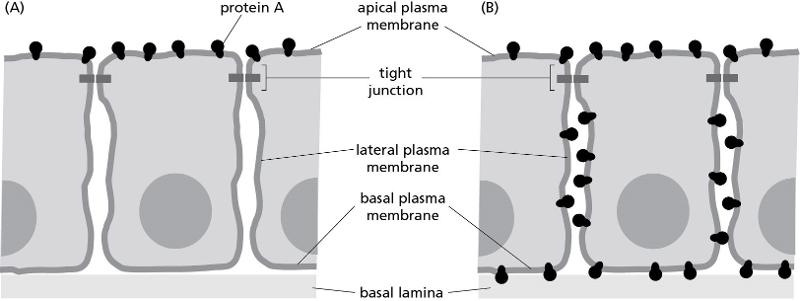
Consider the apical location of a particular protein expressed in epithelial cells, illustrated in Figure Q11-49A. Which type of defect described below is the most likely to cause the redistribution of that protein around the entire cell, shown in Figure Q11-49B?
(a) a nonfunctional protein glycosylase
(a) a nonfunctional protein glycosylase
(b) the deletion of a junctional protein
(c) the truncation of a protein found in the extracellular matrix
(d) a nonfunctional flippase
(c) the truncation of a protein found in the extracellular matrix
(d) a nonfunctional flippase
(a) a nonfunctional protein glycosylase
(b) the deletion of a junctional protein
(c) the truncation of a protein found in the extracellular matrix
(d) a nonfunctional flippase
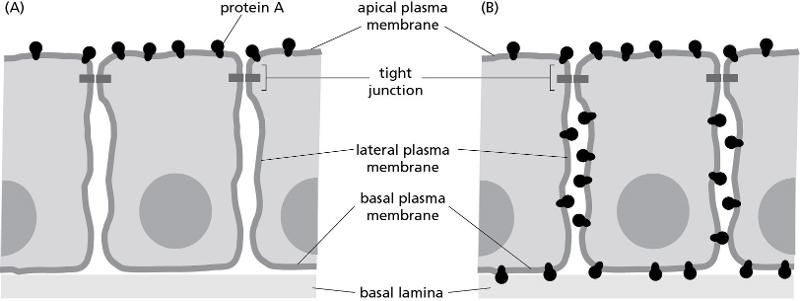
Consider the apical location of a particular protein expressed in epithelial cells, illustrated in Figure Q11-50A. When a molecule that chelates calcium is added to the cell culture medium, you observe a redistribution of that protein around the entire cell, shown in Figure Q11-50B. Which is most likely to be true about the role of calcium in maintaining an apical distribution of protein A?
(a) calcium is required to maintain the structural integrity of the junctional complex
(b) calcium is required for the binding of the junctional proteins to the cell cortex
(c) calcium is a structural component of protein A
(d) calcium inhibits intracellular transport of protein A
(a) calcium is required to maintain the structural integrity of the junctional complex
Diversity among the oligosaccharide chains found in the carbohydrate coating of the cell surface can be achieved in which of the following ways?
(a) varying the types of sugar monomers used
(b) varying the types of linkages between sugars
(c) varying the number of branches in the chain
(d) all of the above
(d) all of the above
Which of the following statements about the carbohydrate coating of the cell surface is false?
(a) It is not usually found on the cytosolic side of the membrane.
(b) It can play a role in cell–cell adhesion.
(c) The arrangement of the oligosaccharide side chains is highly ordered, much like the peptide bonds of a polypeptide chain.
(d) Specific oligosaccharides can be involved in cell–cell recognition.
(c) The arrangement of the oligosaccharide side chains is highly ordered, much like the peptide bonds of a polypeptide chain.
Both glycoproteins and proteoglycans contribute to the carbohydrate layer on the surface of the cell. Which of the following is not true of glycoproteins?
(a) They can be secreted into the extracellular environment.
(b) They have only one transmembrane domain.
(c) They have long carbohydrate chains.
(d) They are recognized by lectins.
(c) They have long carbohydrate chains.
The endothelial cells found closest to the site of an infection express proteins called lectins. Each lectin binds to a particular ____________ that is presented on the surface of a target cell.
(a) oligosaccharide
(b) aminophospholipid
(c) polysaccharide
(d) sphingolipid
(a) oligosaccharide
In order to study the activity of isolated transmembrane proteins, the membrane lipids must be completely stripped away.
true or false
False. The region of the protein that normally crosses the membrane must be stabilized by the presence of phospholipids for the purified protein to be active. For this reason, purified membrane proteins are often reconstituted into artificial lipid bilayers.
FRAP is a method used to study the movement of individual proteins.
true or false
False. The FRAP method involves photobleaching of a small region of the membrane, which contains hundreds of target molecules, and follows the displacement of these molecules with neighboring molecules that have not been bleached.
SDS is a mild detergent that is useful for the reconstitution of membrane components.
true or false
False. SDS is a strong, ionic detergent that will break up membrane bilayers and also denature proteins.
The speed of fluorescent signal recovery during a FRAP assay is a measure of lateral mobility for the molecule of interest.
true or false
True.
We can estimate the relative mobility of a population of molecules along the surface of a living cell by fluorescently labeling the molecules of interest, bleaching the label in one small area, and then measuring the speed of signal recovery as molecules migrate back into the bleached area. What is this method called? What does the abbreviation stand for?
(a) SDS
(b) SPT
(c) GFP
(d) FRAP
(d) FRAP
It is possible to follow the movement of a single molecule or a small group of molecules. This requires the use of antibodies linked to small particles of gold, which appear as dark spots when tracked through video microscopy. What is this method called? What does the abbreviation stand for?
(a) SDS
(b) SPT
(c) GFP
(d) FRAP
(b) SPT
CO2 and O2 are water-soluble molecules that diffuse freely across cell membranes.
true or false
True.
The differences in permeability between artificial lipid bilayers and cell membranes arise from variations in phospholipid content.
true or false
False. The primary difference between cell membranes and artificial membranes is that cell membranes have proteins responsible for creating a selective permeability, which varies with the location and function of the membrane.
Transporters are similar to channels, except that they are larger, allowing folded proteins as well as smaller organic molecules to pass through them.
true or false
False. Transporters work by changing conformation after specific binding of the solute to be transported. Channels exclude molecules on the basis of size and charge, but do not depend on specific recognition of the molecules moving through.
Cells expend energy in the form of ATP hydrolysis so as to maintain ion concentrations that differ from those found outside the cell.
true or false
true
Which of the following channels would not be expected to generate a change in voltage by movement of its substrate across the membrane where it is found?
(a) an aquaporin
(b) a sodium channel
(c) a calcium channel
(d) a proton channel
(a) an aquaporin
Although the extracellular environment has a high sodium ion concentration and the intracellular environment has a high potassium ion concentration, both must be neutralized by negatively charged molecules. In the extracellular case, what is the principal anion?
(a) HCO3 –
(b) Cl–
(c) PO4 3–
(d) OH–
(b) Cl–
We can test the relative permeability of a phospholipid bilayer by using a synthetic membrane that does not contain any protein components. Some uncharged, polar molecules are found to diffuse freely across these membranes, to varying degrees. Which of the following has the lowest rate of diffusion across an artificial membrane? Why?
(a) glucose
(b) water
(c) glycerol
(d) ethanol
(a) glucose
Below is a list of molecules with different chemical characteristics. Knowing that all molecules will eventually diffuse across a phospholipid bilayer, select the option below that most accurately predicts the relative rates of diffusion of these molecules (fastest to slowest).
alanine estrogen propanol sodium
(a) alanine > propanol > sodium > estrogen
(b) sodium > propanol > alanine > estrogen
(c) estrogen > propanol > sodium > alanine
(d) estrogen > propanol > alanine > sodium
(d) estrogen > propanol > alanine > sodium
Cells use membranes to help maintain set ranges of ion concentrations inside and outside the cell. Which of the following ions is the most abundant inside a typical mammalian cell?
(a) Na+
(b) K+
(c) Ca2+
(d) Cl–
(b) K+
Cells use membranes to help maintain set ranges of ion concentrations inside and outside the cell. Which of the following ions is the most abundant outside a typical mammalian cell?
(a) Na+
(b) K+
(c) Ca2+
(d) Cl–
(a) Na+
Cells use membranes to help maintain set ranges of ion concentrations inside and outside the cell. Which of the following negatively charged ions is not primarily used to buffer positive charges inside the cell?
(a) PO4 3–
(b) OH–
(c) Cl–
(d) HCO3 –
(c) Cl–
Negatively charged ions are required to balance the net positive charge from metal ions such as K+, Na+, and Ca2+. Which of the following negatively charged ions is the most abundant outside the cell and which ion does most often neutralize (written in parentheses)?
(a) Cl– (Ca2+)
(b) PO4 3– (K+)
(c) PO4 3– (Ca2+)
(d) Cl– (Na+)
(d) Cl– (Na+)
Which of the following statements about resting membrane potential is not true?
(a) The resting membrane potential for most animal cells is 0 mV, because the positive and negative ions are in balance.
(b) The resting membrane potential for most animal cells is positive, because Na+ ions are so plentiful inside cells.
(c) The resting membrane potential for most animal cells is negative, because the inside of the cell is more negatively charged than the outside of the cell.
(d) At the resting membrane potential, no ions enter or exit the cell.
(c) The resting membrane potential for most animal cells is negative, because the inside of the cell is more negatively charged than the outside of the cell.
A hungry yeast cell lands in a vat of grape juice and begins to feast on the sugars there, producing carbon dioxide and ethanol in the process:
C6H12O6 + 2ADP + 2Pi + H+ à 2CO2 + 2CH3CH2OH + 2ATP + 2H2O
Unfortunately, the grape juice is contaminated with proteases that attack some of the transport proteins in the yeast cell membrane, and the yeast cell dies. Which of the following could account for the yeast cell’s demise?
(a) toxic buildup of carbon dioxide inside the cell
(b) toxic buildup of ethanol inside the cell
(c) diffusion of ATP out of the cell
(d) inability to import sugar into the cell
(d) inability to import sugar into the cell
Ion channels are classified as membrane transport proteins. Channels discriminate by size and charge. In addition to Na+, which one of the following ions would you expect to be able to freely diffuse through a Na+ channel? Explain your answer.
(a) Mg2+
(b) H+
(c) K+
(d) Cl–
(b) H+
Some cells have aquaporins—channels that facilitate the flow of water molecules through the plasma membrane. For these cells, what regulates the rate and direction of water diffusion across the membrane?
(a) aquaporin conformation
(b) resting membrane potential
(c) solute concentrations on either side of the membrane
(d) availability of ATP
(c) solute concentrations on either side of the membrane
Transporters, in contrast to channels, work by ________________.
(a) specific binding to solutes.
(b) a gating mechanism.
(c) filtering solutes by charge.
(d) filtering solutes by size.
(a) specific binding to solutes.
Pumps are transporters that are able to harness energy provided by other components in the cells to drive the movement of solutes across membranes, against their concentration gradient. This type of transport is called _____________.
(a) active transport.
(b) free diffusion.
(c) facilitated diffusion.
(d) passive transport.
(a) active transport.
Facilitated diffusion can be described as the favorable movement of one solute down its concentration gradient being coupled with the unfavorable movement of a second solute up its concentration gradient.
true or false
False. This describes coupled transport, which is one type of active transport. Facilitated diffusion can also be called passive transport, in which a solute always moves down its concentration gradient.
Transporters undergo transitions between different conformations, depending on whether the substrate-binding pocket is empty or occupied.
true or false
True.
The electrochemical gradient for K+ across the plasma membrane is small. Therefore, any movement of K+ from the inside to the outside of the cell is driven solely by its concentration gradient.
true or false
True.
The net negative charge on the cytosolic side of the membrane enhances the rate of glucose import into the cell by a uniporter.
true or false
False. Glucose is an uncharged molecule, and its import is not directly affected by the voltage difference across the membrane if glucose is being transported alone. If the example given were the Na/glucose symporter, we would have to consider the charge difference across the membrane.
Active transport requires the input of energy into a system so as to move solutes against their electrochemical and concentration gradients. Which of the following is not one of the common ways to perform active transport?
(a) Na+-coupled
(b) K+-coupled
(c) ATP-driven
(d) light-driven
(b) K+-coupled
The Na+-K+ ATPase is also known as the Na+-K+ pump. It is responsible for maintaining the high extracellular sodium ion concentration and the high intracellular potassium ion concentration. What happens immediately after the pump hydrolyzes ATP?
(a) Na+ is bound
(b) ADP is bound
(c) the pump is phosphorylated
(d) the pump changes conformation
(c) the pump is phosphorylated
The extracellular concentration of Ca2+ is approximately 104-fold higher than the concentration of Ca2+ in the cytosol.
true or false
True.
The low cytosolic Ca2+ concentration sensitizes the cell to an influx of Ca2+, ensuring a rapid response to environmental stimuli.
true or false
True.
Cytosolic Ca2+ concentration is kept low by the use of chelators such as EDTA.
true or false
False. Ca2+ concentrations in the cytosol are kept low by the action of ATP-driven calcium pumps in the endoplasmic reticulum membrane and the plasma membrane.
The primary mechanism by which Ca2+ acts as a signaling molecule is by increasing the net charge in the cytosol.
true or false
False. Ca2+ binds tightly to many proteins in the cell, which in turn changes their activity. This interaction is the primary mechanism by which Ca2+ signaling occurs.
You have generated antibodies that recognize the extracellular domain of the Ca2+-pump. Adding these antibodies to animal cells blocks the active transport of Ca2+ from the cytosol into the extracellular environment. What do you expect to observe with respect to intracellular Ca2+?
(a) Ca2+-pumps in vesicle membranes keep cytosolic calcium levels low.
(b) Ca2+-pumps in the endoplasmic reticulum membrane keep cytosolic calcium levels low.
(c) Ca2+-pumps in the Golgi apparatus keep cytosolic calcium levels low.
(d) Ca2+ concentrations in the cytosol increase at a steady rate.
(b) Ca2+-pumps in the endoplasmic reticulum membrane keep cytosolic calcium levels low.
Cells make use of H+ electrochemical gradients in many ways. Which of the following proton transporters is used to regulate pH in animal cells?
(a) light-driven pump
(b) H+ ATPase
(c) H+ symporter
(d) Na+-H+ exchanger
(d) Na+-H+ exchanger
Which of the following statements is true?
(a) Amoebae have transporter proteins that actively pump water molecules from the cytoplasm to the cell exterior.
(b) Bacteria and animal cells rely on the Na+-K+ pump in the plasma membrane to prevent lysis resulting from osmotic imbalances.
(c) The Na+-K+ pump allows animal cells to thrive under conditions of very low ionic strength.
(d) The Na+-K+ pump helps to keep both Na+ and Cl– ions out of the cell.
(d) The Na+-K+ pump helps to keep both Na+ and Cl– ions out of the cell.
Ca2+-pumps in the plasma membrane and endoplasmic reticulum are important for _____________.
(a) maintaining osmotic balance.
(b) preventing Ca2+ from altering the activity of molecules in the cytosol.
(c) providing enzymes in the endoplasmic reticulum with Ca2+ ions that are necessary for their catalytic activity.
(d) maintaining a negative membrane potential.
(b) preventing Ca2+ from altering the activity of molecules in the cytosol.
Which of the following occur without coupling transport of the solute to the movement of a second solute?
(a) import of glucose into gut epithelial cells
(b) export of Ca2+ from the cytosol
(c) export of H+ from animal cells for pH regulation
(d) the export of Na+ from cells to maintain resting membrane potential
(b) export of Ca2+ from the cytosol
Which of the following best describes the behavior of a gated channel?
(a) It stays open continuously when stimulated.
(b) It opens more frequently in response to a given stimulus.
(c) It opens more widely as the stimulus becomes stronger.
(d) It remains closed if unstimulated.
(b) It opens more frequently in response to a given stimulus.
Gap junctions are large pores that connect the cytosol to the extracellular space.
true or false
False. Gap junctions are used to connect the cytosol of adjacent cells, allowing the sharing of ions and small metabolites. Because gap junctions are large channels, if they were open while facing the extracellular environment, the ability of the plasma membrane to serve as a permeability barrier would be greatly reduced.
Aquaporin channels are found in the plasma membrane, and allow the rapid passage of water molecules and small ions in and out of cells.
true or false
False. Charged molecules (even protons, which are very small) are not able to pass through aquaporins.
The ion selectivity of a channel depends solely on the charge of the amino acids lining the pore inside the channel.
true or false
False. Selectivity depends on three parameters: the diameter, shape, and charge of the ion trying to pass through the pore of the channel.True.
Most ion channels are gated, which allows them to open and close in response to a specific stimulus, rather than allowing the constant, unregulated flow of ions.
true or false
true
The stimulation of auditory nerves depends on the opening and closing of channels in the auditory hair cells. Which type of gating mechanism do these cells use?
(a) voltage-gated
(b) extracellular ligand-gated
(c) intracellular ligand-gated
(d) stress-gated
(d) stress-gated
Voltage-gated channels contain charged protein domains, which are sensitive to changes in membrane potential. By responding to a threshold in the membrane potential, these voltage sensors trigger the opening of the channels. Which of the following best describes the behavior of a population of channels exposed to such a threshold?
(a) Some channels remain closed and some open completely.
(b) All channels open completely.
(c) All channels open partly, to the same degree.
(d) All channels open partly, each to a different degree.
(a) Some channels remain closed and some open completely.
When the net charge on either side of the plasma membrane is zero, what else is true?
(a) There is an equal number of K+ ions on each side of the plasma membrane.
(b) The K+ leak channels are open.
(c) The electrochemical potential across the membrane is zero.
(d) The resting membrane potential is between –20 mV and –200 mV.
(c) The electrochemical potential across the membrane is zero.
K+ leak channels are found in the plasma membrane. These channels open and close in an unregulated, random fashion. What do they accomplish in a resting cell?
(a) They set the K+ concentration gradient to zero.
(b) They set the membrane potential to zero.
(c) They disrupt the resting membrane potential.
(d) They keep the electrochemical gradient for K+ at zero.
(d) They keep the electrochemical gradient for K+ at zero.
The Nernst equation can be used to calculate the membrane potential based on the ratio of the outer and inner ion concentration. In a resting cell, membrane potential is calculated taking only K+ ions into account. What is V when C o = 15 mM and C i = 106 mM?
(a) 438.1 mV
(b) –52.7 mV
(c) 52.7 mV
(d) –5.3 mV
(b) –52.7 mV
When using the Nernst equation to calculate membrane potential, we are making several assumptions about conditions in the cell. Which of the following is not a good assumption?
(a) The temperature is 37°C.
(b) The plasma membrane is primarily permeable to Na+.
(c) At rest, the interior of the cell is more negatively charged than the exterior.
(d) K+ is the principal positive ion in the cell.
(b) The plasma membrane is primarily permeable to Na+.
If Na+ channels are opened in a cell that was previously at rest, how will the resting membrane potential be affected?
(a) The membrane potential is not affected by Na+.
(b) It becomes more negative.
(c) It becomes more positive.
(d) It is permanently reset.
(c) It becomes more positive.
In a method called patch-clamping, a glass capillary can be converted into a microelectrode that measures the electrical currents across biological membranes. Which of the following is not true about the patch-clamp method?
(a) The glass capillary adheres to a “patch” of membrane through the application of suction.
(b) The aperture in the glass capillary used to make a microelectrode is about 1 μm in diameter.
(c) If the experimental conditions are held constant, fluctuations in electrical currents across the patch of membrane are still observed.
(d) Single-channel patch-clamp recordings have demonstrated that gated membrane channels will only open and close in response to specific stimuli.
(d) Single-channel patch-clamp recordings have demonstrated that gated membrane channels will only open and close in response to specific stimuli.
Neurotransmitters are small molecules released into the synaptic cleft after the fusion of synaptic vesicles with the presynaptic membrane.
true or false
True.
Action potentials are usually mediated by voltage-gated Ca2+ channels.
true or false
False. Action potentials are usually mediated by voltage-gated Na+ channels.
Voltage-gated Na+ channels become automatically inactivated shortly after opening, which ensures that the action potential cannot move backward along the axon.
true or false
true
Voltage-gated K+ channels also open immediately in response to local depolarization, reducing the magnitude of the action potential.
true or false
False. Voltage-gated K+ channels respond more slowly than the voltage-gated Na+ channels. Because voltage-gated K+ channels do not open until the action potential reaches its peak, they do not affect its magnitude. Instead, they help to restore the local membrane potential quickly while the voltage-gated Na+ channels are in the inactivated conformation.
Which of the following statements does not accurately describe the events involved in the propagation of an action potential?
(a) An initial influx of Na+ through a small cluster of channels causes local depolarization of the membrane.
(b) Local depolarization causes nearby Na+ channels to open.
(c) Channels in depolarized regions of the membrane are inactivated until the resting membrane potential is reestablished.
(d) The opening of transmitter-gated K+ channels helps to repolarize the membrane.
(d) The opening of transmitter-gated K+ channels helps to repolarize the membrane.
Which of the following is required for the secretion of neurotransmitters in response to an action potential?
(a) neurotransmitter receptors
(b) Na+-K+ pumps
(c) voltage-gated K+ channels
(d) voltage-gated Ca2+ channels
(d) voltage-gated Ca2+ channels
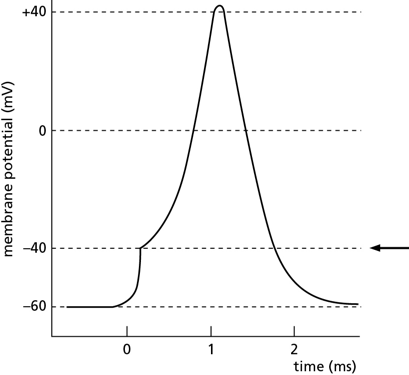
Figure Q12-53 illustrates changes in membrane potential during the formation of an action potential. What membrane characteristic or measurement used to study action potentials is indicated by the arrow?
(a) effect of a depolarizing stimulus
(b) resting membrane potential
(c) threshold potential
(d) action potential
(c) threshold potential
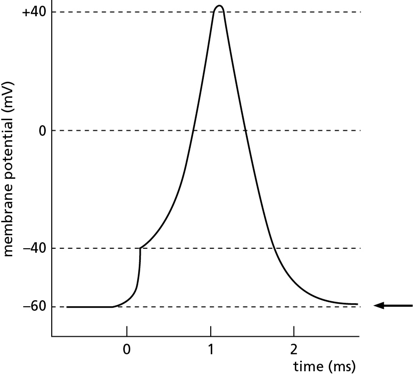
Figure Q12-54 illustrates changes in membrane potential during the formation of an action potential. What membrane characteristic or measurement used to study action potentials is indicated by the arrow?
(a) effect of a depolarizing stimulus
(b) resting membrane potential
(c) threshold potential
(d) action potential
(b) resting membrane potential
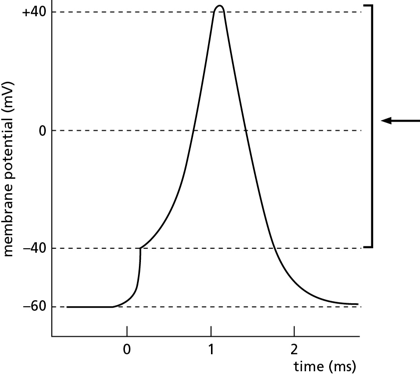
Figure Q12-55 illustrates changes in membrane potential during the formation of an action potential. What membrane characteristic or measurement used to study action potentials is indicated by the arrow?
(a) effect of a depolarizing stimulus
(b) resting membrane potential
(c) threshold potential
(d) action potential
(d) action potential
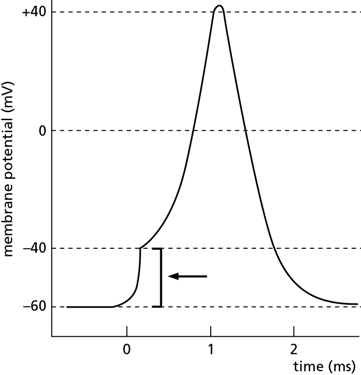
Figure Q12-56 illustrates changes in membrane potential during the formation of an action potential. What membrane characteristic or measurement used to study action potentials is indicated by the arrow?
(a) effect of a depolarizing stimulus
(b) resting membrane potential
(c) threshold potential
(d) action potential
(a) effect of a depolarizing stimulus
The stimulation of a motor neuron ultimately results in the release of a neurotransmitter at the synapse between the neuron and a muscle cell. What type of neurotransmitter is used at these neuromuscular junctions?
(a) acetylcholine
(b) glutamate
(c) GABA
(d) glycine
(a) acetylcholine
Both excitatory and inhibitory neurons form junctions with muscles. By what mechanism do inhibitory neurotransmitters prevent the postsynaptic cell from firing an action potential?
(a) by closing Na+ channels
(b) by preventing the secretion of excitatory neurotransmitters
(c) by opening K+ channels
(d) by opening Cl– channels
(d) by opening Cl– channels
Which of the following statements best reflects the nature of synaptic plasticity?
(a) New synapses are created due to the postnatal generation of neurons.
(b) Synaptic response changes in magnitude depending on frequency of stimulation.
(c) There is a change in the type of neurotransmitter used at the synapse.
(d) Neuronal connections are pruned during normal development.
(b) Synaptic response changes in magnitude depending on frequency of stimulation.
Approximately, how many distinct synapses are established on the dendrites and cell body of a motor neuron in the spinal cord?
(a) tens
(b) hundreds
(c) thousands
(d) millions
(c) thousands
Which of the following statements about GABA receptors is not true?
(a) They are located on postsynaptic membranes.
(b) They are ligand-gated channels.
(c) They inhibit synaptic signaling.
(d) They promote neuronal uptake of Na+.
(d) They promote neuronal uptake of Na+.
Which of the following gated ion channels are involved in inhibitory synaptic signaling?
(a) voltage-gated Na+ channels
(b) voltage-gated Ca2+ channels
(c) glycine-gated Cl– channels
(d) glutamate-gated cation channels
(c) glycine-gated Cl– channels